Nudes, Suckling Pigs, Goeff Dyer & Order In The Photo Files
Thursday, December 31, 2009

A byproduct of old age is the accumulation of stuff. For too many years against the advice of my wife I have been buying books that are now stacked on the floor as the many bookcases in the house are all full. I finally got the message (if a bit late) and I will no longer buy books. I will depend on the excellent stacks of our Vancouver Public Library. But, what if I should want to read the latest by José Saramago in Spanish? His novels are translated from the Portuguese to Spanish at least a year before they become available in English. If I want to read in Spanish I cannot depend on the VPL’s stacks. I will have to buy.
The biggest worry in my mind these days as I toss and turn in bed the waning days of the year has been what to do with 13, four-drawer metal filing cabinets full of my life’s work in the form of negatives, slides, transparencies and prints. I can be objective enough about my own output to know that they are worth money. But to whom and when? Probably when I am dead someone will have a peak and realize what I know now, and that is that I have a diverse treasure of Vancouver’s everyday life since I arrived in 1975.
Every once in a while I have the impulse to phone my friend Celia Duthie who now lives on Salt Spring Island. It would be evident to most that Duthie knows her books and that like many who have been booksellers she is a bit of highbrow! She always points me in the direction of new authors. This time around she mentioned Geoff Dyer who in her opinion is the best young British writer around. His output goes in avery direction. One of the books that Duthie recommended is The Ongoing Moment. It is a book about photography written by a man who confesses that in his travels he does not take pictures and that he does not own a camera. Yet this book is an unusual book about the history of photography.
It is a great book at many levels. Consider that it begins with Jorge Luis Borges’ classification of animals as seen
In The Analytical Language of John Wilkins 1942, Borges describes 'a certain Chinese Encyclopedia,' the Celestial Emporium of Benevolent Knowledge, in which it is written that animals are divided into:
1. those that belong to the Emperor,
2. embalmed ones,
3. those that are trained,
4. suckling pigs,
5. mermaids,
6. fabulous ones,
7. stray dogs,
8. those included in the present classification,
9. those that tremble as if they were mad,
10. innumerable ones,
11 those drawn with a very fine camelhair brush,
12 others,
13 those that have just broken a flower vase,
14 those that from a long way off look like flies.
This classification has been used by many writers. It "shattered all the familiar landmarks of his thought" for Michel Foucault. Anthropologists and ethnographers, German teachers, postmodern feminists, Australian museum curators, and artists quote it. The list of people influenced by the list has the same heterogeneous character as the list itself.
From mentioning Borges’ list Dyer goes on to explain how other photographers filed their own negatives such as Walker Evans and Lewis Hine.

This all made me think of my own personal classification which is not really cross-referenced and installed into some sort of computer program. My filing system is alphabetical and depends on my memory alone. If I forget a person’s name I cannot find the file. I usually call someone with a better memory and ask. Such a person is Charles Campbell who in his term as the Georgia Straight editor assigned me to shoot a lot of people and lots of esoteric stuff that I had never done before like architecture at UBC, architecture on South Cambie or photographs of people who collected toasters. If I were to be asked if I had pictures of people with toasters I would have to call up Campbell to see if he remembers their names!
But short of minor problems I can find just about anything. I have some sublists and they are contained in either separate filing cabinets (I have one for authors) or occupy a large chunk of a particular letter. Letter D has dance and many pictures of dancers. My classification is divided into cars, dance, authors, travel, architecture, family, gardens (including lots of pictures of our own garden since 1986) and finally a whole filing cabinet (four drawers) called nudes. I have one more drawer full of 11/14 inch prints, b+w and colour that I have made through the years and never bothered to throw away. Looking at them now I am glad I didn’t as many are printed on premium photographic paper.
I have not finished Dyer’s book, but thanks to Celia Duthie, below, I think that I will be better prepared this coming year to sort through my stuff and put further order into it before I make my final exit.

For those who might wonder why I post, every now and then a picture taken in a cheap hotel room (the Marble Arch in most cases) I would like to point out that around 1977I was influenced by a couple of slim books called Petersen's Masters of Contemporary Photography. One was called Photo Illustration - Bert Stern - How To Turn Ideas Into Images. The other was Photographing Sensuality - One Man's View of Fantasy and Realism In the Female Form J. Frederick Smith. This latter photographer started his career as a noted magazine illustrator and he then shifted his interests into photography. His b+w phtographs of beautiful women (looking like they had just woken up) in hotel room beds with rumpled sheets and coffee cups on the floor inspired me to one day try it. This I have many times to my satisfaction and that of my models.
J. Frederick Smith
Tossing & Turning - Veracruz 1968
Wednesday, December 30, 2009
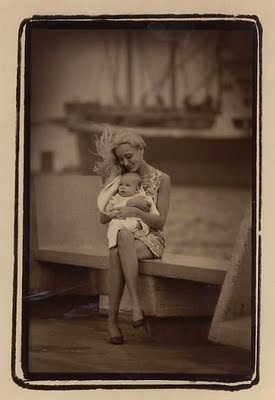
As I toss and turn in bed this early morning of December 31, 2009 I can but only think of a much more memorable one of December 31, 1968. Our oldest daughter Alexandra Elizabeth had been born in August of that year and weeks later we had visited my mother in the port city of Veracruz in our VW Beetle. We had driven at night on a Friday and almost there I took a hairpin curve much too fast. I lost control of the car and we turned over. Only a few weeks ago I had purchased a new pair of Firestone tires that came with a pair of free seat belts. At the time they were not obligatory in cars. The seat belts saved our lives. Little Ale in the back seat was in a wicker crib that had a little hood over it. That saved her. Some motorists helped us right the car and the lopsided mess somehow took us to my mother’s home on Calle Navegantes. I do not remember too well but I suspect that one of the helping motorists took Rosemary and Ale in their car while I manhandled our vehicle to keep it on the road.
The car was fixed eventually and my mother met her first granddaughter.
We returned that Christmas in the repaired car (it's behind Rosemary and Ale in the second picture) and spent a very hot and muggy holiday complete with several nortes that brought even more heat and high winds with sand that got into everything.

For New Year’s eve Rosemary and I walked on the Malecón (the broad avenue that hugged the port and the Gulf of Mexico. Later that evening we got into bed waiting for the moment when all the ships docked at the port would sound their wailing horns in a happy and very loud introduction into 1969. We got out of bed and with my mother we all hurriedly ate 12 grapes each, before the horns stopped, for good luck.
As I toss and turn on the eve of 2010 I miss that humid heat of Veracruz and my mother’s smile. I miss the sense of opportunity and that unfettered excitement that a whole life was in front of us. Who was to guess then, that we would be here in Vancouver so far from all that? As my Argentine friend Juan Manuel Sanchez would have said, “We are penguins in the arctic.” We are at home yet so far from it.

As I toss and turn I feel comfort that Rosemary is right there beside me. I feel comfort that little Ale is happy in her home in Lillooet. I feel comfort that Hilary and Bruce are giving their two daughters, Rebecca and Lauren a good home and instilling in them a sense of what’s right and what’s wrong. As I toss and turn I feel the comfort of our two cats Toby and Plata who happily sleep nearby with no worries in the world. After all someone has to toss and turn. And that’s me.

Azar - The Beauty Of Randomness
Tuesday, December 29, 2009

azar.
(Del ár. hisp. *azzahr, y este del ár. zahr, dado1, literalmente 'flores').
1. m. Casualidad, caso fortuito.
Diccionario de la Real Academia Española
Azar
La palabra azar viene árabe الزهر (az-zahr) que significaba primero "flor" y luego se empleó para la marca que daba la suerte en la taba, que era la rótula de un mamífero mediano, como una oveja o una cabra. En la taba, antecesor del dado cuadrado, se marcaba con una pequeña flor uno de sus lados, que era el que daba la suerte. En el juego que en árabe y otras lenguas de Oriente se llamó نرد (nard), en español tablas reales, en francés tric-trac y en inglés backgammon, el dado se llama زهرة النرد (zahrat an-nard), literalmente "la flor de las tablas reales". El uso de الزهر (az-zahr) con el significado de dado hizo que en castellano se introdujera el arabismo azar con el significado del latín alea. (ver aleatorio).
From el origen de las palabras
This is about randomness and the beauty that I have found through it. Because it is about randomness I feel I can justify my going into different directions. Not a couple of months ago I read in my NY Times, in a business article, about the decline of magazines. The writer reflected on the space constraints of magazines and especially in relation to ad content. The writer went on to make a statement that registered in my brain. It was something like, “Space in magazines is limited, on the web the real estate [my italics] is infinite.” With that in mind and considering that I have not editor I will do so as I please and write to whatever length this finally ends up in.
For years I have absolutely despised flamenco in all its forms. I cannot stand the music, gypsies sitting on small stools playing what passes as dramatic music while other men and women clap their hands. I cannot abide by the stamping of feet on tables (as seen in Hollywood films about Mexico. Curiously early American directors equated flamenco with Mexico) or the playing of castanets. I loathe them.
Part of my reason for disliking flamenco I can squarely place on the shoulders of my snobbish mother who deprecated Spanish music. She told me that the best songs about Spain had been written by Mexican composer, Agustin Lara (one version of La Malagueña) of by Cuban Ernesto Lecuona (the other better known Malagueña). Se further cited Edouard Lalo’s Opus 21 in D minor Symphonie Espagnole written for Spanish virtuoso violinist Pablo de Sarasate. She would end her argument telling me that Rimsky Korsakov’s Capriccio Espagnol sounded more Spanish than most Spanish music. She did not have to tell me about Bizet’s opera Carmen to put the nails on the Spanish coffin. I eventually agreed with her in 1961 when I my new craziness for American jazz I bought Miles Davis’ Sketches of Spain. If it was Miles Davis it had to be good.

I hated the first track on my record which was Joaquín Rodrigo’s Concierto de Aranjuez. I refuse to listen to it to confirm here my suspicion that you can hear castanets in it. The other tracks I learned to like and they have grown in my estimation through the years. But soon after Sketches of Spain you could hear versions of Rodrigo’s composition with solo clarinet, bass saxophone, voices and probably even with a kazoo accompaniment with the Swingle Singers. In Spanish when you really don’t like something you say, “No me gusta ni en pintura.” Or I don’t like it even as a painting. The Concierto de Aranjuez is up there with the theme song from Around the World in 80 Days and Doctor Zhivago’s theme Lara. I loathe all three.

In the 80s Vancouver had a renaissance of Greek restaurants. My wife’s favourite was Orestes. In these restaurants you were destined, no matter how you avoided it, to see a belly dancer which in my mind (I will cite here my ignorance on all things flamenco) was flamenco’s poor cousin via the gypsies that came from India. To make it all worse these belly dancers replaced castanets with little thumb metal devices that made a noise that would pierce into my head and produce an instant migraine without having to indulge in retsina. I dislike retsina as much as I dislike feta cheese and calamari. If I went to Greece I would live solely on olives (I love them) and the Greek version of that Italian concoction called pizza.
Sometime in the middle 90s before the local business magazine Equity ceased to publish, its publisher Ronald Stern gave one of his celebrated Christmas parties. To my horror the entertainment was to be a flamenco singer and dancer. The dancer Jocelina, see below, left, entered like a hurricane, with a shockingly black head and a body to die for. When she spotted me she winked. I immediately recognized her as a former habitué of that establishment on the corner of Main and Powell. As a blonde I had known her as Jocelyn and I had photographed her as a belly dancer. She proceeded to slithering around in a most graceful way. This she did to the singing of a man who was telling us a mournful tale of loss. A mournful tale of loss it was, to those who did not understand Spanish! Rosemary and I were trying to control our laughter:
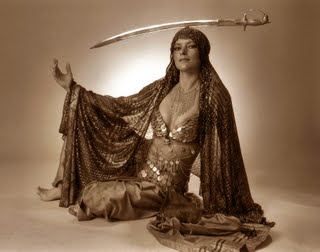
Rich men shave with warm water. I am a poor man and I must shave with cold water. Alas I am a poor man and must shave with cold water. This is so unfair, so unfair.
He repeated that as a Gillette-like mantra.
My second thoughts on my hate of all things flamenco and the nether regions of the belly occurred when I saw Sarita, above, left, the belly dancer. She had formerly been a flamenco dancer. She was from Puerto Rico, she spoke Spanish and looked like the most beautiful Gypsy I had ever met in my life. I wasn’t the only one who had fallen for Sarita’s charms.
Alex MacGillivray, the restaurant writer for the Vancouver Sun wrote a review at the Kilimanjaro ( in Gastown) in which he did not mention the food once. His piece was all about Sarita!
I photographed Sarita, and, no matter how inexperienced I might have been, her pictures were some of the most overtly erotic I have ever taken. I found that my best recourse was to avoid her and to swear a life free of castanets, flamenco, stamping on floors and in particular that tongue slapping noise that belly dancers make that propels me to pull my hair. I have not seen Sarita since.
One potato, two potato, three potato, four.
Five potato, six potato, seven potato, more.
(Then the person would remove the fist on the word "more" and the game
would begin again.
Eenie, meenie, meinie, moe
Catch a niger[ that’s how I learned it in Buenos Aires in the 40s] by the toe
If he hollers
let him go
Eenie, meenie, meinie, moe
The Spanish version (I first heard it in Mexico) of the above youthful study into randomness is the much more satisfying:
De tín marín
de do pingüé,
cúcara, mácara, títere fue.
Yo no fui;
fue Teté.
Pégale, pégale
que ella fue.
But since the above are used to randomly choose something (two teams to play soccer at recess, is an example ) there is a purpose to that sort of randomness that is not subject to the vagaries of a more unsettling kind like leaving home and forgetting to lock the door. You remember, you get out of the car and lock the door. You drive off and, blocks away, you get into a fender bender. “Why did I have to forget to lock that door…?”
The word random in English to me has a mathematical ring to it. It brings to my mind Einstein's famous quote, "God does not play dice with the universe." The word is almost neutral unless I make the connection with "random violence" or "random killing". Then the word has a more sinister tone to it. In Spanish the expression is “al azar”. The word azar comes from the Arabic and originally it had to to with a knuckle bone from a sheep on which you would paint symbols including a flower (azhar is Arabic for flower) and play an ancient game which eventually let to dicea and other games of chance. To further make that word azar so beautiful, it was used by the Spaniards exclusively to name the white flowers of citrus fruits. Before Odorono came into Spanish life, agua de azhar, or citrus flower water hid the smells of infrequent bathing.
Randomness has changed, of late, a lot of my prejudicial perception on taste in the arts. It was the randomness of looking for movie DVD’s at the man branch of the Vancouver Public Library (Videomatica I now inform you that I will be spending less money at your establishment) that led to my current conundrum (not much of one, as I will admit that I have suddenly changed my mind) on flamenco.

At those stacks I found Spanish director Carlos Saura’s, right, Amor Brujo, 1985, (third of the trilogy that was preceeded by Blood Wedding, 1981, and Carmen, 1983). I decided to give it a go as I had seen previously one of the best films ever, Saura’s Goya in Bordeaux, 1999, and I think that his Tango, 1998, is the finest film ever made about Argentine tango.
Amor Brujo (based on the ballet by Manuel de Falla which I saw with Rosemary and my two granddaughters last Saturday) begins with one of the most remarkable and long tracking shots that would give Hitchcock a jealousy of indigestion. The dancing is superb and there is not one castanet to bee seen anywhere. The set is a huge car dump with an earthen floor. There is no zapateo (
foot stamping).

The main protagonist, Antonio Gades (photo above, right by Lorenzo Cebrian, is one of the most strikingly beautiful men I have ever seen. His partner, Cristina Hoyos, below centre in as still from Amor Brujo, is not as beautiful as a third girl, Laura del Sol, bottom right with gades, also in the cast. Rebecca asked me why this was and I had to explain that Saura did not cast actors because they were actors or even good looking actors. He preferred to cast very good dancers as actors regardless of their looks. This I confirmed when I found out that Gades(seen in all pictures here and lifted from Google images) was the most noted flamenco dancer of his generation, that he was the director of the National Ballet of Spain. Gades choreographed all the numbers of the trilogy. Cristina Hoyos’ curriculum credits were as good.
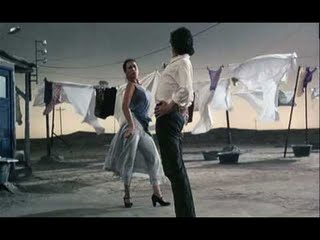
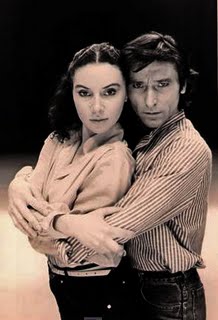
After this film (which Rebecca enjoyed and Rosemary commented, “The Spanish is so brief and so easy to understand.”) I have taken out the remaining films of the trilogy at the Vancouver Public Library! We are set for a Saura Saturday flamenco marathon.
I just might look for Sarita and see what I can do with my camera to capture a dance which I have suddenly come to understand thanks to Saura and the help of that wonderful randomness of the stacks of our Vancouver Public Library. I am certain that if my mother had ever seen any of these films her respect for real Spanish music might have grown. Luckily it wasn't too late for me to change my mind.
no castanets and no foot stamping with Antonio Gades and Cristina Hoyos
Gargoyles & The Winged Victory
Monday, December 28, 2009
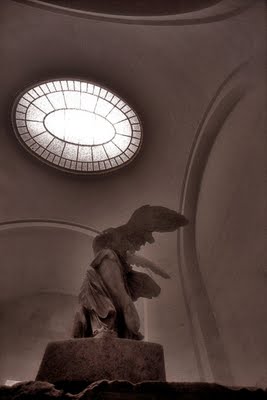
Just like anybody else I dream. And just like everybody else when I wake up in the morning most of those vivid dreams have faded and only bits and pieces of them remain. I am unlike Graham Greene who kept a notebook and pen handy by his bedside table. During the night it would seem that he could will himself awake during interesting dreams and he would jot down the jist of them before memory failed.
This morning I woke up, and just for once I could remember the dream. The dream, which was about Paris may have come to my sleeping imagination because I am reading a Barbara Cleverly Commander Joe Sandilands novel, Foly Du Jour which is set in Paris in 1927. The dream involved a faded, blurry Winged Victory and a Notre Dame gargoyle. I went to my files and looked around. I wasn't too surprised what I found in one six-frame negative. Three of the the frames were of the Winged Victory at the Louvre and the other three were the gargoyles on the roof of Notre Dame. While the pictures are not absolutely sharp (I used Kodak Infrared film) the are not blurred at all. But the dream indeed was accurate as to the relationship between them.
Winged Victory of Samothrace
The Winged Victory of Samothrace is the name given in English to a statue of the Greek goddess Nike (Victory), found on the island of Samothrace (Greek Samothraki) in 1863 by the French archaeologist Charles Champoiseau. It is now in the Louvre, Paris. In Greek it is called the Niki tis Samothrakis (Νίκη της Σαμοθράκης) and in French La Victoire de Samothrace). There are numerous copies around the world. The Victory is considered one of the great surviving masterpieces of Greek sculpture, even though it is missing its head and arms. It is by an unknown artist and is thought to date from about 190 BC (though some scholars date it as early as 250 BC or as late as 180 BC). A partial inscription on the base of the statue includes the word "Rhodhios" (Rhodes), indicating that the statue was commissioned to celebrate a naval victory by Rhodes, at that time the most powerful maritime state in the Aegean. The Samothrace Archaeological Museum, however, says that the statue was an offering donated by the Macedonian general Demetrius I Poliorcetes after his naval victory at Cyprus. This would date the statue to 288 BC at the latest.
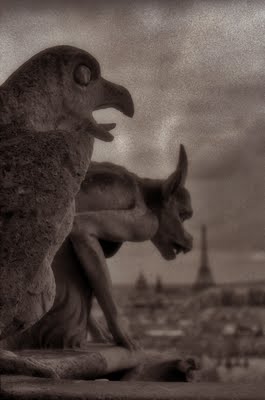
The statue originally stood on the prow of a stone ship, probably as part of an outdoor altar, and was intended to represent the goddess as she descended from the skies to bring victory to the fleet. Before losing her arms she had been blowing a victory paean on a trumpet. In 1950 one of the statue's hands was found on Samothrace and is now in a glass case in the Louvre next to the podium on which the statue stands. The statue shows a mastery of form and movement which has impressed critics and artists since its discovery. The Victory is one of the Louvre's great treasures, and it is displayed in the most dramatic fashion, at the head of the sweeping Daru Staircase. The loss of the head and arms, while regrettable in a sense, is held by many to enhance the statue's depiction of the supernatural.

Writers & Company, Eleanor Wachtel & Novelizing My Wife
Sunday, December 27, 2009

I try to avoid reading the NY Times’ travel section on Sundays. The beautiful articles about exotic places I would like to visit don’t put me into a vicarious mood. I sometimes don’t want to read about Venice. I want to go to the real Venice. But today Sunday I could not possible avoid the cover with its banner headline Stendhal In Parma by Adam Begley. The heading contains:
There’s the city that sprang from the imagination of the author of The Charterhouse of Parma and there’s the real place. Both are worth exploring.
Since both of Stendhal’s best known novels, The Red and the Black and The Charterhouse of Parma are part of my book collection I was intrigued and read on. It was a rewarding experience particularly this:
The fact that Stendhal (né Marie-Henri Beyle) contrives to give us a feel for Parma without pausing for a single descriptive passage is a literary feat the reveals a curious truth about realism and the power of suggestion. Show us the effect a place has on those who spend time there, and there’s no need to supply brick-by-brick visual detail. The same goes for characters in a book: Show us how others react to them, and we feel we know them, that we would recognize them on the street. Consider for example Stendhal’s hero, an idealistic youth who survives his impetuous decision to run off at age 16 to fight for Napoleon, and whose subsequent career becomes the business of nearly everyone else in the novel. Though you might not notice on first reading, Fabrice is never described physically; we learn only that he’s a “fine looking boy” wildy attractive to women. Our best clue to how Stendhal sees him is a minor character’s remark that Fabrice has a “Corregio contenance.”
That above passage produced a nagging impact in me. It was only a week before that I happened to listen to the beginning of an interview by Eleanor Wachtel (Reader’s & Company) with English literary critic and novelist James Wood. The interview was so gripping that when I arrived home I ran in and immediately turned on my radio tuner in the living room so that I was able to hear the whole 55 minute interview. In this interview James Wood said something like this, “We can never know people as well as we can know the protagonist of a novel. We get to know the protagonist through the interaction with other characters in the novel.”
That above statement is as obvious as the one that I only found out just a few years ago. You cannot have nostalgia for a place when you are living in it! Obvious it is but not quite.
After I heard Wood I went upstairs and stared at Rosemary. We have been married 42 years. I stared at her and came to the conclusion that I don’t know her.
In my repeated readings of C.S. Forrester’s Hornblower novels I am forced to read between the lines, to guess what is in the mind of Hornblower at any given time. In Gregory Peck’s immersion into Hornblower in the film Captain Horatio Hornblower (1951) he is bang on. This is one of my favourite films of all time. Peck doesn’t say much. An expression here, the pursing of a lip there is all you need to know what is inside of Hornblower’s mind.
And of course in Patrick O’Brian’s “better” nautical novels featuring Captain Aubrey and his medical sidekick Maturin the reader gets to know them intimately. Yet Hornblower is as vivid in my mind as is Aubrey.
The author of the NY Times article on Parma, Adam Begley argues most convincingly that even though Stendhal writes little about the real Parma, it is still a Parma that has never been characterized better since.
It was sometime around the middle 80s that I photographed Eleanor Wachtel for Western Living Magazine. The magazine featured a pretty monthly column by a local writer and it was called Forethought. Wachtel was gracious, friendly and easy to photograph.
When I listen to her program, Writers & Company, I like the way she tries to keep her own contribution to the conversations with authors at a minimum. It was a few months ago that I heard her interview with Irish writer Edna O’Brien. It was terrific. I managed to find out that it was available as a podcast. I got my limited computer knowledge working and I was able to download it and copy it to a CD which I sent to my first cousin and godmother Inesita (86) in Buenos Aires who enjoyed the interview as much as I did. I played the CD in our bedside clock radio for Rosemary. She enjoyed it, too.
Today I downloaded not only Wachtel’s interview with James Wood but one with Paul Theroux. For those who might be interested in following suit be aware that the podcasts are up for only ten days!
As for getting to know the real Rosemary I am going to try to "novelize" her. I am going to notice how my family and friends interact with her. This could be exciting and revealing.
Satin Sheets & Flying Down To Rio
Saturday, December 26, 2009

On December 1964 I flew from Mexico City to Buenos Aires via Panama and Rio de Janeiro. At the time there were few direct flights and if one booked carefully there were certain advantages to flying indirectly. For one it meant that I stayed overnight in Panama City in a luxury hotel, not far from the airport of Tocumen, courtesy of the airline (Pan American) which showed its appreciation for my having to adjust to the "discomfort" of indirectness. My memory is fuzzy but I do know that the bellboy who opened the door to my room, asked me if I wanted company for the night. He added that he could arrange for it. I declined. I was surprised to find that my sheets were light blue satin. It was the first and last time I ever slept between satin sheets.
The flight to Rio was in a most unusual jet plane. Few (only 37) had been built. It was a Brazilian Airlines Varig, Convair 990. Their claim to fame at the time was that they were faster (635MPH and according to my friend and airplane expert Sean Rossiter, the fastest subsonic airliner ever) than the then standard of the jet age, the Boeing 707. My 990 had four General Electric CJ805 turbojets that generated 16,500 lbs of thrust each which were the civilian versions of the J79 that powered the Lockheed F-104 and the McDonnell Douglas F4 Phantom.
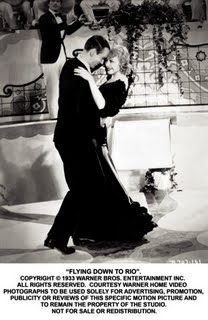
I had carefully chosen a Varig flight that did not have immediate connections to Buenos Aires. This meant that VARIG paid for my night at the Hotel Gloria. It was this hotel that had been featured in that film (all I remembered was that number where beautiful girls danced on the top of a monoplane while holding cables atached to the wing) Flying Down to Rio with Fred Astaire, Ginger Rogers and that most beautiful of actresses the Mexican Dolores del Río. The hotel had been at its apogee when Flying Down to Rio was made in 1933 it was a tad run down but still aware of its proud heritage. I was informed at the front desk that I was obliged to wear a suit and tie if I were going to dine at the hotel.
The dining room was a huge affair complete with a spiral staircase in one corner. I was the only patron. At any moment I imagined that Barbara Stanwyck might show up or that I was going to experience a dance duo, the Carioca, by Astaire and Rogers. That did not happen. A man in a full tuxedo came in and sat down at a grand, Steinway grand. He acknowledged my presence with a pursing of his lips and began to play flowery romantic piano sonatas. After my meal the also liveried waiter asked me if my meal had been to my satisfaction. I told him it had been. I didn't want to seem rude by pointing out that my Argentine compatriots would have said that the steak (it was tough) was "carne cansada" or tired meat which is the result of allowing cattle to roam at will for kilometers to get their food. Before leaving I went up to the piano player and asked him what a particular lugubrious piano piece had been. In perfect English he replied, “That was Mort! - Lamentation pour Piano by L.M. Gottschalk which the composer dedicated to his friend Monsieur Le Comte Gioannini."

The next morning at the airport there were only two passengers getting on the flight to Buenos Aires. I was one of them and the other was a burly middle-aged American. The Brazilian authorities told us we needed to have smallpox shot before we could get on the plane. We looked at each other as both of us had a document attached to our passports that attested to it. The burly man said he did not need a new vaccination and that this was duly recorded in his American passport. The Brazilian official told him that it was not considered an acceptable one as there was no legible date attached to the proof of inoculation. The American began to scream at the official, “We Americans have propped up your country with all type of aid and money. The least you can do is to show some appreciation and wave this.” It is my belief that the American arrived safely in Buenos Aires minus his smallpox inoculation but his luggage was probably sent to Montevideo. The Brazilian doctor, before he injected me with the vaccine, smiled at me and explained that the vaccine was not obligatory and that I had an option to pay and not get it. I decided that my best route was to indulge him so I bribed him. My luggage and arrived at Buenos Aires.
A Cleverly Christmas Day
Friday, December 25, 2009
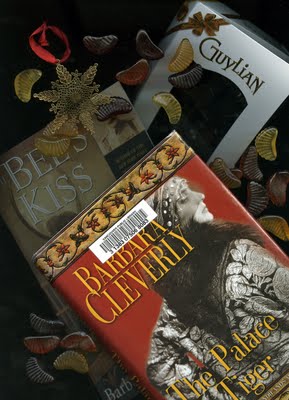
Because we celebrate Christmas on Christmas Eve and our granddaughters and parents go and visit their other relatives on Christmas Day we are left with a day to do nothing. For me that is the real spirit of Christmas Day.
The late morning began with breakfast in bed (as usual). I brought up a tray with two glasses of orange juice, sliced bananas with brown sugar for Rosemary and toast (from Rebecca’s homemade bread for me. A mug of strong tea was for me while for Rosemary I brewed some of her decaf. The only newspaper (reading the newspaper is part of our early morning routine) was a Vancouver Courier. The NY Times does publish on Christmas Day but delivery is still curtailed in Vancouver. The Christmas edition is delivered on Boxing Day with the Boxing Day edition.
I never did take off my nightgown and I only got out of bed during the day to replenish my tea and indulge in Christmas stocking goodies as my favourite (once-a-year) Guylian Belgian Chocolate Sea Shells, and Efruti fruit juice slices.

I read two books, Barbara Cleverly’s The Palace Tiger and The Bee’s Kiss. The latter transfers Scotland Yard Commander Joe Sandilands (bottom, right) back to his home in London after four novels in the The Raj of the 1920s. One of those four novels, Ragtime In Simla I have reserved at the Vancouver Public Library. They have only two copies and both are out. Perhaps I am not the only one on a Cleverly Christmas binge.
Cleverly's four Raj Sandilands novels have re-injected an interest in all things British India (the Raj) so I have been consulting my copy of Velerie Pakenham's Out in the Noonday Sun - Edwardians in the Tropics.
The re-reading of Pakenham's book suddenly put me into contact with a most interesting character that seems to have slipped my mind. It was ornithologist (Birds of Arabia, 1930) Richard Meinertzhagen (1878-1967) who fought in India and East Africa and by the time he had command he used vicious tactics of reprisals called the Punjab Principle before settling in as a brilliant Intelligence Officer for General Allenby in the Palestinian campaign in WWI. Pakenham writes:
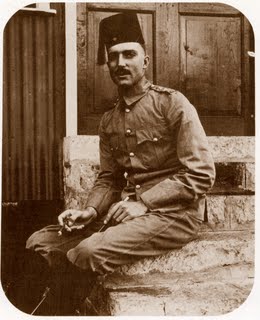
Richard Meinertzhagen found himself back in Europe early in 1917, seconded to the War Office, Kitchener's last disastrous post. Meinertzhagen had made himself a brilliant reputation in the East African capaign as Chief Intelligence Officer where he evolved a highly original method of collecting information about the enemy's strength and movement. He called it the D.P.M. - Dirty Paper Method - since it depended largely on salvaging jettisoned doucuments from the enemy's latrines.
...In December he was relieved to be posted to another sideshow - the Palestinian campaign, this time as Chief Intelligence Officer to Allenby, the first general for whom he soon had unstinted praise. He set up his D.P.M. system again to report on Turkish activities and in October carried out in person one of the war's most daring coups. He rode up alone within sight of the Turkish lines, near enough to be shot at, then, wheeling about, apparently wounded, he dropped a bloodstained haversack in mid-flight. The haversack contained carefully forged plans of a n Allied attack on the Turk's western front, among other personal documents; it fooled the Turks sufficiently to allow Allenby's real offensive a few weeks later to Beersheba to go through relatively unopposed.

That Commnder Joe Sandilands dispatches two, over ten foot tigers, within minutes in The Palace Tiger with his Holland and Holland Royal double 23-inch barrel rifle does not in the least seem all that extraordinary when I read Pakenham's brief story on the fighting ornithologist!
Chicken A La Barbara & Toby Hams It Up
Thursday, December 24, 2009
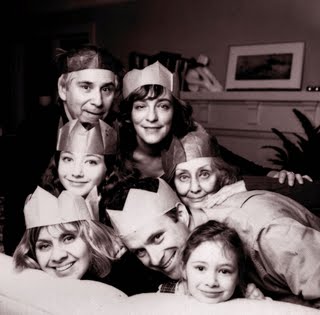
Sometime around 1971 my mother returned from a long stay with her brother Tony in North Carolina. I remember very well that she looked at me and said, “You have always thought me to be a terrible cook. You have been right, but now I am going to prove to the contrary. I can cook. She showed me a pocketbook which she had purchased in Greensboro, Marion Brown’s – Southern Cook Book , new edition, August 1970. She had tried some of the recipes under the supervision of Uncle Tony’s wife and most competent cook, Renate.
My mother cooked the most heavenly chicken I have ever had, Adalyn Lindley’s Chicken A La Barbara.
Serves Six to Eight
1 roasting chicken 1 stalk celery
1 cup flour Carrots, parsnips, parsley
Salt, celery salt, pepper 1 qt. water
paprika to taste 1 tablespoon flour seasoned
chicken giblets with salt and pepper
Tops of wings and neck ½ cup cream
Mix flour and seasonings and rub chicken inside and out with mixture. Melt ¼ pound of butter and rub over seasoned fowl. Take the chicken giblets, top of wings and neck, a celery stalk, carrots, parsnips and parsley (desired amount of each vegetable) and put into about 1 qt. of water. Cook like soup for 1 hour. Strain. Mix 1 tablespoon seasoned with salt and pepper with ½ cup cream. Thicken stock with this. Put the chicken in a hot oven until slightly browned. Every 15 minutes pour ¼ cup stock over. When it is used up put cover on chicken and let simmer in oven until done.Special permission, Adalyn Lindley, Manager, Neiman-Marcus Tea Room, Dallas Texas.
We had Chicken a la Barbara for our Christmas Eve dinner. I have made this recipe before so I have modified the recipe for a whole cup of cream and a half a qt more of stock. The sauce is so good that you need more to serve over the chicken and the white rice I usually serve it with. We had cucumber salad, roasted red, green, and yellow peppers with onion. To drink we had a BC rosé wine and ice cold spiced apple juice. For dessert Rebecca made cookies and a blueberry/apple pie from scratch. I had our special container that converts cream into real whipped cream.
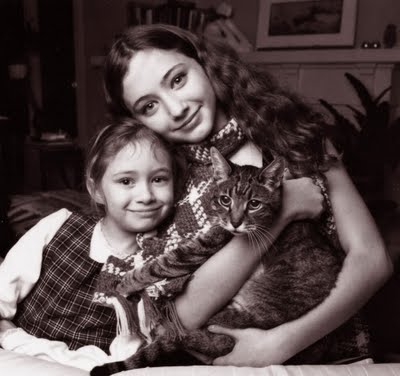
Before we opened the presents I snapped a few Fuji instant b+w prints. One would have been enough except I overexposed the first one and Hilary systematically closed her eyes for the subsequent ones. In the end I liked and somewhat corrected the over-exposed one. The second picture features Rosemary’s 19-year-old cat Toby. Bruce Stewart made Toby look lively with some expert gesticulation.
To any who may be reading this blog I wish them a Merry Christmas.
Jo-Ann & A Hot Summer's Day In December
Wednesday, December 23, 2009
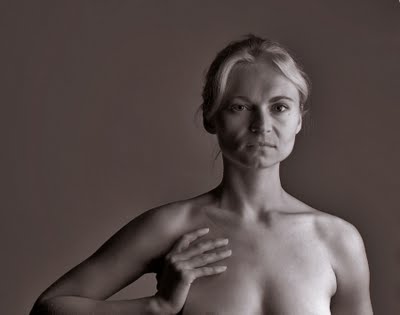
December 23 is a strange day. It is not Christmas Eve, it is not Christmas. There is a fine lethargy to the day in which I usually do nothing but read and drink tea. I did just that today, nothing. But the blog beckoned and I had to think of something. I looked at the mess that is a winter garden and imagined it in the spring again. Then I thought about the heat of summmer, those rare Vancouver summer days when it is really hot. Those are the days that are dearest to my heart. They bring in nostalgia for the heat of Mexico or of my native Buenos Aires. Indeed December 23 is usually one of the hottest days of the Buenos Aires summer. But today the heat took me to my files of Jo-Ann, the Thursday Girl.
In late summer I took pictures of Jo-Ann the "Thursday Girl" who came to my studio a few Thursdays per year beginning in 2006. Here you see one of the first pictures and one of the last, on the roof of my studio.
Jo-Ann is of Dutch origin and perhaps that suggests to me that she has a 15 century Flemish painting kind of face. It is strong. She shows confidence and equanimity. For some strange reasons few of my pictures of her are my usual portraits or nude portraits. She somehow blends into the backgrounds and becomes a whole with it.
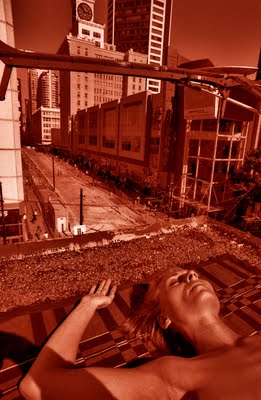
The first picture is one of the most remarkable nudes I feel I have taken. Unfortunately I had to crop it because of my policy of not showing full nudes in my blog. Her hand is perfect and she projects in the full nude the stability of the Golden Gate Bridge. I am not in any way intimating that she is not slim. She is!
The second picture which I have tinted red suggests to me the heat of that day in early September. You cannot "see" the noises that were coming from the pneumatic hammers that were drilling into the intersection of Robson and Granville. The ruckus did not faze Jo-Ann in the least.
I dislike reading the newspapers at this time of the year with their “year in pictures” or “the year that was”. I noticed a picture today in the NY Times of Bush looking out of the window of his not-quite-the-presidential-helicopter as he left DC. It seems a century ago. I don’t want to look at more of those pictures.
I want to look at pictures of Jo-Ann on the roof of my studio on a hot afternoon. It is my hope that Jo-Ann will not discontinue our Thursdays.
The Christmas Gift - The Record
Tuesday, December 22, 2009
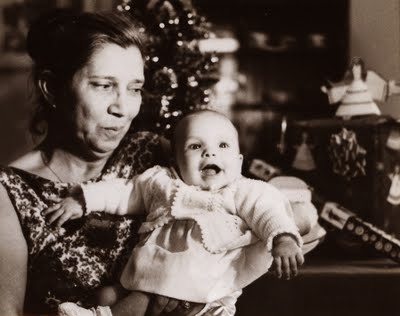
I have written on these pages (screens?) before here about my mother’s first love and the fact that she never made me forget that my father somehow was her second choice. By the logic of the little boy that I was (and in some ways I still am) I came to the conclusion that I, too was second best.
That first love in Manila in the late 30s ended in a revelation that I suspect but have refused until now to explore further. I think I will leave it for another year. That first love somehow disappointed my mother who then threw an opal ring into Manila Bay and soon after she, her mother, brother and sister moved to Buenos Aires where by 1942 I entered the picture.
When my mother died we had her notebook of poems bound in beautiful leather. It is called Things and Thoughts after one of the poems. It is only in the last few years that I have come to realize to what point my mother was obsessed in her love for Doctor Ramón Andía. The notebook begins in Mexico City in 1955. There are poems written in Nueva Rosita, Coahuila and Veracruz, Veracruz and ends February 1972 in Mexico City (from our home in Arboledas) a year before her death.
I hinted that the casting of the ring into Manila Bay was the result of a thick letter that Dr. Andía wrote to my mother. This letter was at my mother’s side and is now in the centre drawer of my desk here, as I type this. From a Filipino wedding in North Vancouver where I met a nephew of Ramon Andía I found out he never married. Another relative was more candid and told me, “Dr. Andía was gay.”
Below you will find two poems one is called The Record and is dated Dec 10, 1956. My mother would have written this poem in Nueva Rosita, Coahuila, Mexico as well as the second one, The Christmas Gift dated, Dec 13, 1956. I will copy them in reverse order. In light of what I have written about Dr. Andía above, you might catch on to the subtlety in which my mother writes of her despair.
The Christmas Gift
What shall I get you for Xmas?
A silver bell that’s tinkle you to merriness,
A candy cane, some sugared plums, nuts and raisins,
So you’ll taste the sweetness of Xmas cheer?
“That’s not for me.”
Is this more appropriate?
A staid plum pudding dipped in rhum,
A bottle of golden apple cider,
An eggnog with cinnamon and nutmeg,
And spices from the east.
A fat red Xmas candle dustily aglitter with snowflakes,
A silver star with a shiny tail like a comet?
(All these have the evergreen tang of the many Xmases I didn’t share with you.)
You stare at me & shake your head,
And I must say, “Oh it’s just a fantasy.”
I still wonder
What shall I get you for Xmas?
The Record
He came along sheepishly
A record behind his back
And nonchalantly said,
“I brought you a record
It was mine and now it is yours.”
It was an old-fashioned 78
Nicked at the edges; played very often
It’s jacket was thumbed and worn.
I thought to myself,
“Couldn’t he find something better?”
And then I looked at the two titles
One the first side I read, “I Love You Truly”
On the other, as finishing a sentence
“Nevertheless.”
The photograph is of my mother holding our 4-months-old first daughter Ale. It was Christmas 1968 in Veracruz, Mexico
Supersedure
Monday, December 21, 2009
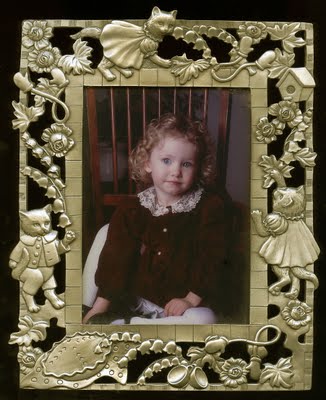
While in the pay of the Argentine navy I was seconded to the US Naval Advisory Group. This meant that I had a secretary and lots of privileges that many of my fellow Argentine conscripts. I had access to large tins of Edgeworth pipe tobacco and other goodies that came from the PX. But I had to such boring and onerous tasks as filing US Naval reports. Many were bulletins that superseded earlier ones. I had to find the older documents and replace them with the new ones. The idea was that the superseded document could contain dangerous instructions that had not been caught until the new bulletin came in.
The verb supersede was a popular verb in the US Navy and I really don’t think that replace quite means the same thing. As a way of showing this I have as an example a photograph I took of Rebecca when she must have been two or three. When Rosemary saw it she smiled and loved it. In fact in was her favourite for some years. The frame is over the fireplace mantel of our den. If I were to put it away Rosemary would notice immediately.

For me the picture has been superseded by all the rest that came after. I cannot even look at the picture with the nostalgia of the little girl that was. Rebecca is much more interesting as she grows up. There is a superficiality (of someone who has not lived enough to have any kind of depth) in her cuteness that contrasts most unfavourably with her present self. She is more dynamic, more intelligent and more argumentative. She is almost an adult and I find her to be a good friend.
I wonder if this latest picture which I took on Saturday will soon be superseded by something else.
Pancho Does Not Smile For Christmas
Sunday, December 20, 2009
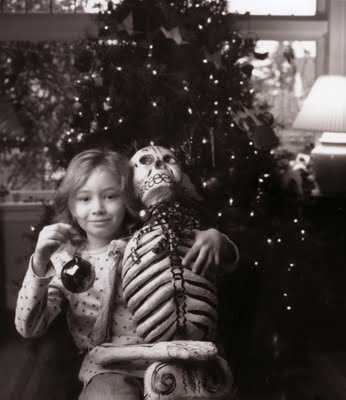
Sunday was really the first day of our Christmas holiday. Rosemary and I lingered in bed reading the Sunday New York Times and after feeding the cats, they came back and we stayed in bed. I continued reading Barbara Cleverly’s (no relation to Penelope Lively) The Last Kashmiri Rose which is a novel that is part of her series set in 1920s British Imperial India and features a Scotland Yard investigator and Flander’s Field veteran, Inspector Joe Sandilands. I was hooked when my neighbour Patricia Hutter lent me The Damascene Blade. Staying in bed to read without feeling guilty and keeping our financial worries buried (just a bit) is what Christmas is all about.
The two girls arrived in the morning to find the Douglas Fir tree I had purchased earlier. Rosemary strung up the lights and Lauren and Rebecca did the decorations. My not so subtle cultural “indoctrination” was not to be interrupted by the holidays so I put on a CD of Lotte Lenya singing Kurt Veil’s The Seven Deadly Sins and Berlin Theatre Songs. Rebecca found her odd and after looking at her picture said she was ugly. But I think she began to tolerate the voice. The important factor is that she has been exposed. As contrast I put on my CD of J.J. Johnson and Andre Previn playing the music of Kurt Weil.
Our friend Paul Leisz gave us a turkey for Christmas but Rebecca insisted in cooking it herself at home yesterday. We had a sumptuous pre-Christmas dinner at Rebecca’s (and Lauren’s, Hilary’s and Bruce’s) last night. For me it was a special pleasure (and a bit of a relief) to not have to cook or wash the dishes. Everybody was there including Rebecca and Lauren’s other grandparents.
We left early in the evening and I got into bet to continue with The First Kashmiri Rose.
What to post for yesterday’s blog? I came up with the idea of showing our tree (if only in b+w) so I took a Fuji instant print of Lauren with Pancho, who was given to us by Abraham Rogatnick last year. We will miss him for Christmas Eve. Lauren said to Pancho, “Please don’t smile.” Pancho, much in character, obeyed her.
Rebecca In Red - Revisited
Saturday, December 19, 2009

If there is anything that I have been doing with some sort of continuity this almsot past year, it is my informal study on how people look at images now that the internet is such a big player.
I don’t think that much hullaballoo would result now if Vanity Fair were to put a nude pregnant actress, body painted) in a handbra pose on its cover.
Demi Moore’s picture by Annie Leibovitz in August 1991 happened in a digitally unawakened era. Vanity Fair would have to up the ante by placing Elin Nordgren in a similar pose but with the banner, “Tiger is not ever going to hold this baby in his arms.”
My photograph of Rebecca which I took sometime in August 1995 caused a bit of stir when I had it up at one-person show at a gallery at the end of that year. The very large giclée (a well made inkjet print on very good artist's paper) was purchased by local photography collector and philanthropist Yosef Wosk. People kept asking me, “Why would anybody want to buy a large photograph of your granddaughter?” My answer was the one given to me by Wosk himself which I remember as, “Alex I was unsettled by your granddaughter’s mystical expression.”
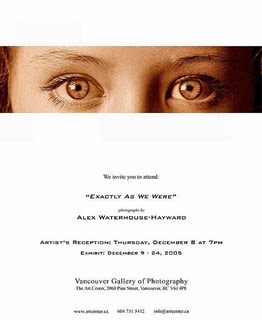
As I look at it now I can see that if I posted it here and mentioned I took it yesterday I could be accused of some sort sexually unethical behaviour on my part. The internet was not as prevalent in 2005 as it is now and the web youth and child exploitation police were in their infancy. They would perhaps object to two little flowered straps on her shoulders. They would object to the not neutral red tinting.
Yesterday I took 20 eposures of Rebecca sitting at the chair by my computer. She objected and put a condition, “I will pose if you will play Risk with me.” I hate playing board games but I thought that my “sacrifice” was worth it if I got Rebecca’s cooperation.
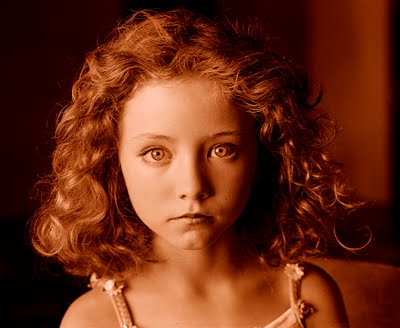
The picture you see here (at the very top) is the Fuji, b+w instant print that I took before I resorted to “real film” (as Rebecca calls film!). I scanned today Sunday and as I studied it (and particularly when I tinted it red) I realized I had a close facsimile of my iconic portrait of 2005. But I did it one better. This version (my mouth salivates as to what must be in the can or as latent images in that roll of 220 Kodak Plus-X) does not have the straps and is much tighter. By cropping in I have eliminated part of Rebecca’s beautiful charm which is her glorious hair. This picture is a safe version of the one from 2005 and will not cause stir with anybody I know. She now looks more ageless than ever before. Is she 6, 10, 12, 20 or even older?
Oh how photography can lie while it reveals!
Twitterizing Time
Friday, December 18, 2009
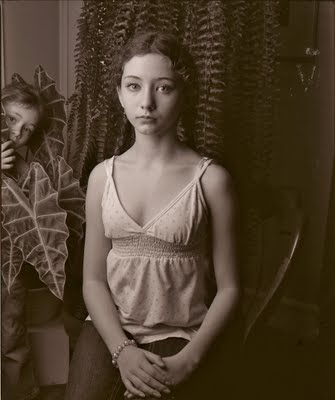
Twitterize
–verb (used with object), -ized, -izing.
1. The act of enabling a person/object to access Twitter.
2. To show a person the wonders of Twitter.
high school kid - hey, are you twitterized yet?
college dude - Dude, I'm totally going to twitterize Shelly from Calculus tonight.
Business person - Hey, are you twitterized yet?
Now that I no longer have that magical gray wall of my studio as a background I must adapt and content myself with taking pictures of Lauren and Rebecca at our home. I have found a few sweet spots inside when it is raining outside and much too cold to take portraits in the garden. One of the sweetest is next to the Boston fern in our dining room. There is nice window lighting coming from the front garden but in all the pictures you see here I ignored it and used my trademark 2x3 ft soft box with one Dynalite flash head shooting through it. Usually, my light is at 45 degrees to my camera. I then raise the light and point it down 45 degrees. This light setup was pioneered by Bert Stern for Cosmopolitan and many call it cleavage lighting! The double 45 degree light will most often create an upside-down triangle on the darker side of the face. Coming from one side, the light mimics the window light I so often ignore.

At this point I would like to coin a new word. The new word, twitterize, already exists with another meaning. See above. I am going to "Alice" it to my own purpose. My meaning has all to do with the shortening of everything because of our brief attention spans and our reduced time for leisure.
We were supposed to have more time, and essays 20 years ago planted the pleasant problem of what we were going to do with all that leisure time we would have in our hands once automation came to our rescue. Those essays never predicted the modern smart phone, texting, Twitter, Facebook and wanting to read a magazine like Sports Illustrated in a special format apped (a verb much in use now!) to our smart phone. We had not yet invented the concept of multitasking.

Our world is getting twitterized. This means that most of what we do has to be done in a reduced period of time. This approach, in which even messages in Facebook, are getting to resemble Twitter in that they are becoming more and more compact, has especially affected photography.
The modern DSLR or its poor cousin, the point and shoot digital camera enables photographers to take pictures anywhere under any lighting conditions. When those conditions get grim the little pop-up flash (or the built-in one) takes over. The overall result is a portrait in which the central flash produces no shadows on the face. It flattens that sense of three dimensionality that a light on one side will create. This side light was a light the the Flemish and Dutch painters mastered. This kind of picture, the one taken with that little central flash (photograph for me would be too kind a word so I will settle on picture), when reinforced by a forced or crazy smile, is what people expect and see now.

Some of the newer cameras even have (I kid you not!) a built-in smile sensor so that the camera will take that snap when the smile is at its apotheosis. These modern cameras are really no different from the older professional cameras that had attached motor drives. Film was expensive but we used to say, “Film is the cheapest part of photography so shoot!” But with the advent of digital cameras shooting lots is truly cheap and most attractive. So people shoot lots in less time.
The idea of placing a big camera in front of Rebecca or Lauren and attaching it to a heavy tripod, takes time. The idea of setting up a light and placing inside a soft box, takes time. The idea of measuring the light (once it has been positioned to Bert Stern’s specifications) with a good flashmeter, takes time. Talking to one’s subject and making them look into the lens and respond to one’s instructions, takes time.
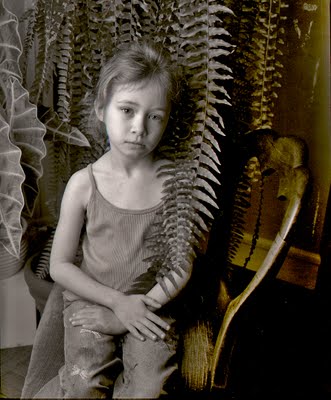
Taking four or five pictures, doesn’t take time. But all the time that preceded the pressing of the shutter will result in a few striking (simply because they are not the norm) portraits that fewer photographers are taking now as a memory for how portraits were once taken and lit begins to fade in our age of twitterized time.
And of course I caught on to the Flemish and the Dutch many years ago. My Lauren and Rebecca rarely smile.
Between Child & Woman
Thursday, December 17, 2009

In the summer of 1994 Celia Duthie asked me to review a photography book for her beautiful little review magazine, The Reader. The book was a book that had caused some controversy in the US. It was Sally Mann’s Immediate Family. That book has been in my mind since and more so recently. The colour pictures you see here I took of Hilary (Rebecca’s mother) in the 70s, at Queen Elizabeth Park when she was 5. When she was 13 and her older sister 16 I had local art photographer James La Bounty photograph them. “Why would you do that?” many of my friends asked. “You are a good photographer. Why don’t you photograph them yourself?” My answer was always, “I see them as little girls because I am their father. James will see them, perhaps, as women.” But even then I wasn’t taking photographs of them as I do now of Rebecca. I cannot explain that I may have more fascination for a granddaughter, perhaps because she is that bit more detached from me than my daughters were. Or I could be a better photographer now so the portraits go more to the core of who Rebecca is. Or it could be a combination of that and the fact that Rebecca puts out a face to the world that is impossible not to notice.
Here is what I wrote:
Immediate Family by Sally Mann
Aperture, New York, $34.95
Photographers don’t always talk technical. Was it F-5.6? Was the film dunked in dilution B? They often discuss the last good photograph they took or a photography book that wrenched them out of a long photographer’s block. Few of the many released photo books have this kind of visual power. I ran into photographer Fred Herzog in Kitsilano recently. He complained to me: “The problem with the Vancouver Public Library is that most of their photography books are by John Hedgecoe.” This prolific English photographer of countless how-to books is photography’s answer to Barry Manilow.
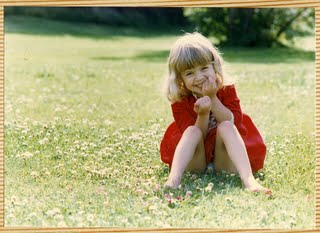
Photography books are not a recent phenomenon, although Richard Avedon’s plan to publish 10 in the next little while might be pushing the dreaded photographer’s bet-noir – overexposure. Good photo books have been around since Henry Fox Talbot published his Pencil of Nature in 1844. Because halftone reproduction of photographs in books had not been invented yet, Talbot personally hand-pasted his Talbotypes into every book. If you can find one of these it’ll cost you upwards of $250,000. At $90 a copy, George Hurrell’s Hollywood is a bargain.
Style is a rare commodity. Two English photographers of the 19th century, Calcutta-born Julia Margaret Cameron (the Annie Leibovitz of her time) and Charles Dodgson (Lewis Carroll) had style. Both photographed Alice Liddell (the original Alice) and both would have spotted her likeness in the pages of Sally Mann’s Immediate Family.
Between 1985 and 1990, American photographer Sally Mann photographed her three children, son Emmett and daughters Jessie and Virginia, at home in the nearby foothills of the Blue Ridge Mountains. The black and white photographs were all crisply taken with an 8x10 camera, a big and cumbersome item of equipment that Dodgson or Cameron would instantly have been comfortable with. The photographs are pastoral, funny and sad. Some are disturbing. In 1994 it is difficult to look at pictures of near-naked or naked little boys and girls without feeling slightly uncomfortable, even after knowing that these are artfully crafted family photographs taken by their mother. Few, if any, of these photographs would look like traditional family pictures even if they were photocornered onto a black paged album, dates and names in white ink. Perhaps what novelist Ann Beattie said n Mann’s earlier book, At Twelve: Protraits of Young Women, applies: “These girls still exist in an innocent world in which a pose is only a pose – what adults make of that pose may be the issue.”
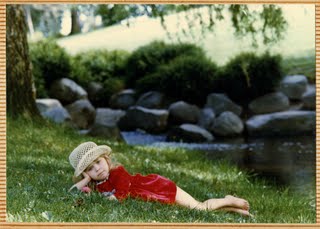
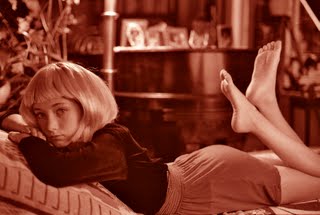
A paradox of parenthood is that while we parents might boast about how our one-year-old son can walk and talk, we are usually the last to notice when our children cease to be children. French Jesuit Pierre Teilhard de Chardin likened the slow upward journey of primeval slime towards life to ever-diminishing, circular planes from a sliced cone. In many of the photographs, but particularly in Candy Cigarette, 1989 (below), Jessie beckons like Helen for her Paris. She could be on either side of that threshold – Teilhard’s point – between child and woman. She seems to be undecided. But for the moment, captured by Mann’s magic lens, Charles Dogson wrote in Through the Looking Glass:

In a Wonderland they lie,
Dreaming as the days go by,
Dreaming as the summers die…
Wednesday, December 16, 2009

“Were we made for this”
December 16, 2009
Alex kindly invited me to provide a piece as a guest on his blog having looked at a recently completed piece I did in reaction to the incredible amount of money being spent on the Vancouver 2010 Winter Olympics.
I watched the raising of the city's first big corporate sponsored building advertisement, over the façade of the landmark Bay store, at the corner of Granville and Georgia. It wasn’t so much the shots of the Bay clad athletes (I applaud dedication and the spirit of the Olympians) that took my attention, but the marketing phrase “We were made for this”, then looked at all four corners of the intersection only to see the signs of Vancouver’s ongoing shame in the form of three regular and homeless individuals vying for their daily needs from passers-by and I truncated the marketing with “Were we made for this”, and the accompanying pictures of the homeless speaks for itself.
We’ve all read in the local, national, and even international press about the ever increasing issue of homelessness in our city. We’ve heard our politicians talk the talk, but the problem seems to increase each year with little political will to create a climate of caring and more importantly change for those less fortunate in our society, the homeless.
The facts “Greater Vancouver’s homeless crisis continues to grow at a “stunning” and “shocking” rate, with a 373-per-cent increase in street homelessness since 2002”, a story in The Vancouver Province, September 17, 2008, demonstrating the reckless disregard and neglect of a long standing issue in our city, and yet, we can spend (and ESTIMATED as we speak) $600 million dollars on this 4 week corporate event for a privileged few to travel on a road going nowhere for the average BC resident, legacy projects that serve an elite and small group of Vancouver citizens and the promise this will boost investment and tourists to our fine city, province and country. We are told, or it is implied, we should perhaps stay away during the event, and watch the mushrooming over the wall security network, being paid by you and I, push the likely cost of these games to over $600 million.
Ian Bateson, Creative Director
Baseline Type & Graphics

I tell my photography class students that they must cultivate a photographic relationship with the people they photograph. I don’t like to use the term model and so opt for the less deprecatory subject. Paradoxically, while model brings to mind a human being that we treat as an object (if we are rude and do not know any better) a subject (which could be an animal or even a theme or thing) seems to be more human. For me when I call my models subjects I want to put forward the idea that a human being stands or sits in front of me and there is a mutual interaction which I hope is a pleasant or at least a tolerable one.
The photographic relationship involves taking pictures more than once. At Focal Point I have an average of 8 or 9 students per class and when we have a shooting day (3 hours) we have two subjects in two adjoining studios. My students shoot like mad trying to get everything they can in those three hours. They must face having a good idea that is then copied by a fellow student that is watching. Sometimes the copy is better than the original. I tell them this is the way it is (to learn under adversity) until they get enough nerve to find a subject they find interesting and then dedicate multiple private sessions with them in which that photographic relationship grows to the point that in some cases verbal communication is not necessary.
I photographed Tarren for something like 25 years until she tired of it. But I have Yuliya and the Thursday girl, Jo-Ann who usually poses for me on Thursdays about four times a year. Our sessions will have to shift to my living room now that my studio is no more. I enjoy looking at the big fat files that are dated for each session so I can observe the progression of change and age.
By the above standards, one of the best subjects I have ever had is my 12 year-old granddaughter Rebecca. I have been giving a lot of thought to the nature of my pictures as she gets older and I will probably elaborate on this later on in the week or month.
More often than not she faces my camera cheerfully after some initial protestation. Here you see her as I photographed her last Halloween in my dining room with Abraham’s Mexican skeleton. This is one of those unintended double exposures or perhaps the long shutter caught her eye movement. Rebecca looks spooky. Spooky in this day and age is a safe mode. And I wonder just why.
At one time I am sure some ultra conservative Catholic Spaniard from my grandmother’s side of the family would have protested at the religious travesty of the theme. My grandmother would have smiled and simply said, “Nobody understands artists. Alex and I are both artists.” She would have winked a conspiratorial eye at me and I would have known that everything was all right.
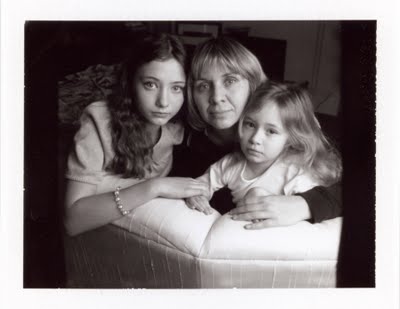
37 years and about nine months ago Rosemary arrived at the Mexico City airport from visiting her parents in Ottawa. She was radiant in a beautiful, very tight and very short orange mini dress. We went home and she seduced me. I never did ask. I suspect that her parents might have recommended that a second child might help iron out whatever difficulties Rosemary might have with her Latin husband. I remember that night.
Hilary was 37 today. It seems only yesterday that Hilary was a few weeks old and my mother said, “She has beautiful hands.” And it seems it was only yesterday that she was 4 or 5 and we were in the posh dining room of the St. Francis Hotel in San Francisco and Hilary was crying loudly (below, right) and having a berrinche (a Mexican tantrum). The beautifully dressed waiter came up to me and said, “Sir is there anything we can do for the young lady?” I was too stupid to understand that he wanted to help so I answered, rudely, “If you can find her some beans and tortillas that will make her stop.”
She is 37 today and when I gaze at her I gaze at the face of my mother. She has her ways, especially her patience to deal with her two, sometimes difficult little girls.
Bruce and Hilary arrived at 6. We prepared a cheese fondue and Rebecca had made a delicious chocolate cake from scratch. Bruce and I indulged in a bottle of Argentine Torrontés white wine. We were all at the table and I cannot think of anything better except perhaps our Christmas Eve dinner to come.

After dinner I took two Fuji instant pictures of the three girls. In the first they smiled, that kept them happy, in the second they didn’t and that made me happy.
Rosemary and I are so lucky.

“Were we made for this”
December 16, 2009
Alex kindly invited me to provide a piece as a guest on his blog having looked at a recently completed piece I did in reaction to the incredible amount of money being spent on the Vancouver 2010 Winter Olympics.
I watched the raising of the city's first big corporate sponsored building advertisement, over the façade of the landmark Bay store, at the corner of Granville and Georgia. It wasn’t so much the shots of the Bay clad athletes (I applaud dedication and the spirit of the Olympians) that took my attention, but the marketing phrase “We were made for this”, then looked at all four corners of the intersection only to see the signs of Vancouver’s ongoing shame in the form of three regular and homeless individuals vying for their daily needs from passers-by and I truncated the marketing with “Were we made for this”, and the accompanying pictures of the homeless speaks for itself.
We’ve all read in the local, national, and even international press about the ever increasing issue of homelessness in our city. We’ve heard our politicians talk the talk, but the problem seems to increase each year with little political will to create a climate of caring and more importantly change for those less fortunate in our society, the homeless.
The facts “Greater Vancouver’s homeless crisis continues to grow at a “stunning” and “shocking” rate, with a 373-per-cent increase in street homelessness since 2002”, a story in The Vancouver Province, September 17, 2008, demonstrating the reckless disregard and neglect of a long standing issue in our city, and yet, we can spend (and ESTIMATED as we speak) $600 million dollars on this 4 week corporate event for a privileged few to travel on a road going nowhere for the average BC resident, legacy projects that serve an elite and small group of Vancouver citizens and the promise this will boost investment and tourists to our fine city, province and country. We are told, or it is implied, we should perhaps stay away during the event, and watch the mushrooming over the wall security network, being paid by you and I, push the likely cost of these games to over $600 million.
Ian Bateson, Creative Director
Baseline Type & Graphics
A Photographic Relationship
Tuesday, December 15, 2009

I tell my photography class students that they must cultivate a photographic relationship with the people they photograph. I don’t like to use the term model and so opt for the less deprecatory subject. Paradoxically, while model brings to mind a human being that we treat as an object (if we are rude and do not know any better) a subject (which could be an animal or even a theme or thing) seems to be more human. For me when I call my models subjects I want to put forward the idea that a human being stands or sits in front of me and there is a mutual interaction which I hope is a pleasant or at least a tolerable one.
The photographic relationship involves taking pictures more than once. At Focal Point I have an average of 8 or 9 students per class and when we have a shooting day (3 hours) we have two subjects in two adjoining studios. My students shoot like mad trying to get everything they can in those three hours. They must face having a good idea that is then copied by a fellow student that is watching. Sometimes the copy is better than the original. I tell them this is the way it is (to learn under adversity) until they get enough nerve to find a subject they find interesting and then dedicate multiple private sessions with them in which that photographic relationship grows to the point that in some cases verbal communication is not necessary.
I photographed Tarren for something like 25 years until she tired of it. But I have Yuliya and the Thursday girl, Jo-Ann who usually poses for me on Thursdays about four times a year. Our sessions will have to shift to my living room now that my studio is no more. I enjoy looking at the big fat files that are dated for each session so I can observe the progression of change and age.
By the above standards, one of the best subjects I have ever had is my 12 year-old granddaughter Rebecca. I have been giving a lot of thought to the nature of my pictures as she gets older and I will probably elaborate on this later on in the week or month.
More often than not she faces my camera cheerfully after some initial protestation. Here you see her as I photographed her last Halloween in my dining room with Abraham’s Mexican skeleton. This is one of those unintended double exposures or perhaps the long shutter caught her eye movement. Rebecca looks spooky. Spooky in this day and age is a safe mode. And I wonder just why.
At one time I am sure some ultra conservative Catholic Spaniard from my grandmother’s side of the family would have protested at the religious travesty of the theme. My grandmother would have smiled and simply said, “Nobody understands artists. Alex and I are both artists.” She would have winked a conspiratorial eye at me and I would have known that everything was all right.
Seduced By Rosemary - A Hilarious Consequence
Monday, December 14, 2009

37 years and about nine months ago Rosemary arrived at the Mexico City airport from visiting her parents in Ottawa. She was radiant in a beautiful, very tight and very short orange mini dress. We went home and she seduced me. I never did ask. I suspect that her parents might have recommended that a second child might help iron out whatever difficulties Rosemary might have with her Latin husband. I remember that night.
Hilary was 37 today. It seems only yesterday that Hilary was a few weeks old and my mother said, “She has beautiful hands.” And it seems it was only yesterday that she was 4 or 5 and we were in the posh dining room of the St. Francis Hotel in San Francisco and Hilary was crying loudly (below, right) and having a berrinche (a Mexican tantrum). The beautifully dressed waiter came up to me and said, “Sir is there anything we can do for the young lady?” I was too stupid to understand that he wanted to help so I answered, rudely, “If you can find her some beans and tortillas that will make her stop.”

She is 37 today and when I gaze at her I gaze at the face of my mother. She has her ways, especially her patience to deal with her two, sometimes difficult little girls.
Bruce and Hilary arrived at 6. We prepared a cheese fondue and Rebecca had made a delicious chocolate cake from scratch. Bruce and I indulged in a bottle of Argentine Torrontés white wine. We were all at the table and I cannot think of anything better except perhaps our Christmas Eve dinner to come.

After dinner I took two Fuji instant pictures of the three girls. In the first they smiled, that kept them happy, in the second they didn’t and that made me happy.
Rosemary and I are so lucky.
Sunday, December 13, 2009
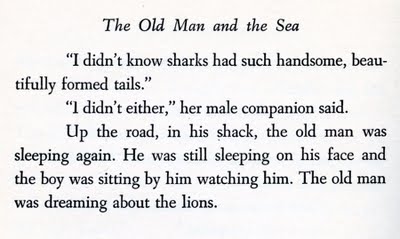
I like to look at the back page of the NY Times’ Sunday Book Review. The page is always an ad for Bauman Rare Books and I enjoy looking at the greatly enhanced prices of books that were once commonplace but as years pass few remain. It is that which explains the inflated prices.
As an example there is Charles Lindbergh We: The Flier’s Own Story 1927. First edition, boldly signed by Lindbergh (bold by advertiser) $5200.
It would seem that enough time has elapsed to erase from the many the memory of the fact that Lindbergh was a Nazi sympathizer. Being Nazi sympathizers has taken the shine off the erstwhile royals, the Duke and the Duchess of Windsor. Not too many people would now bid for original rolls of toilet paper from the bathroom of their suite in New York City.
No such bad reputation attaches to the literary achievement of Charles Dickens. The ad in Bauman’s Rare Books reads: A Christmas Carol 1843 “The one great Christmas myth of modern literature.” First edition, with four hand-coloured engraved plates, finely bound in full morocco-guilt, $15,000.
I remember passing by Bauman Rare Books in one of my trips to NY City. It is on Madison Avenue. I peaked through the windows and realized that I would have never been allowed entry, in my jeans and longish hair. But I did dream then.
Alas I no longer dream about going into Bauman Rare Books.
Ernest Hemingway The Old Man and the Sea 1952 “Man is not made for defeat.” First edition of Hemingway’s classic $3500.
I went into one of my lawyer’s book cases in the living room and took out my own personal copy of The Old Man and the Sea. It is a first edition but is worth less because it has no dust jacket and it is signed by its former owner, my neighbour’s son Carter Smith. Hemingway’s book came our way with a 100 year old Chickering baby grand when the Smiths had to move. Mr. Claire Smith was forgetting who he was.
I showed the book to Rosemary who said, “We might have to sell it.” At one time I would have been terribly upset – not anymore. I think I crossed a bookish Rubicon a month ago when I decided I was not going to buy any more books and that I was going to depend solely on the excellent stacks of the Vancouver Public Library.
Even before my decision I had already started a campaign of buying fewer books. I bought fewer expensive-just-out books this year and depended more on Chapters’ remainder section. And indication of that is that for the first time in my memory, in the NY Times Book Review annual (today) list of the 10 best books of 2009 there is not one in the list (five non-fiction, five fiction) that I have already read or wish to read. The only possible candidate would have been Raymond Carver – A Writer’s Life by Carol Sklenicka. I have a feeling that this good book would probably depress me as Carver’s life was not a happy one. One thing I do not need now is a book that depresses me.

As I look around my house and the thousands of books I realize that sooner or later many, if not almost all, have to go before I go. My friend, bookmeister Robert Blackwood, who suffered a severe stroke recently, once told me that there are some books that one does not want to read again. He divides his extensive book collection in such a parameter. As much as I loved the books of Tony Hillerman I know I never want to re-read any of them (except his 1971 Fly On the Wall which is a non American Indian themed novel). I can see getting rid of them. The problem is that few used books stores these days are willing to hand out cash as they themselves are going through troubled times as people switch to flat screen TVs and reality shows. Books are slowly becoming worthless, that is except at Bauman Rare Books.
It is important for me to understand that the value that I give to my own books is a value that I can measure by the pleasure they have given me in entertainment and knowledge. Even if I were to fling them into a dumpster their real value would not be diminished. Alive I am proof of it.
And, believe it or not, I have been tempted buy one book (two volumes) from Bauman Rare Books that at one time was almost within my reach. My Vancouver Public Library only has it listed as a Gutenberg Library electronic asset. This means that I can download it to my computer and then print it out in hundreds of pages. I will buy (if I do) from Abe Books. The book in question is as listed by Bauman Rare Books is:
Ulysses S. Grant's Personal Memoirs, first edition. Grant's classic Civil War autobiography ranks among the greatest military memoirs in history, two volumes in original cloth, $750.

In the compression of memory that might just be its normal course, as one gets old, is my memory of two films I saw in 1960. One of them was supposed to be my first dirty movie and I dragged my roommates from the Catholic boarding school St. Edward's in Austin, Texas. In spite of its title, The Virgin Spring was not a “dirty” movie but the first Ingmar Bergman film I saw. The other film was The House of Usher, shortened from Edgar Allan Poe's story title, The Fall of the House of Usher. As I sat in the little movie house on Congress Avenue I could never have suspected that I would one day photograph both its star, Vincent Price and its noted producer Samuel Z. Arkoff.
In my memory was the vision of Vincent Price (as Roderick Usher) playing a harpsichord. The other vision was of Technicolor blood oozing from the walls. I was 18 years old and the film scared me. It had to. It left that lasting impression considering that I went to the movies much more then. Yet I only remember those two, the dirty film that wasn't and The House of Usher.
Last week I read Edgar Allan Poe’s The Premature Burial after lunch to Rosemary and Rebecca. They both hated it. Rebecca tried to stop me, telling me that if I persisted she was going to pull out her hair. This she did, to my astonishment. I did not think it appropriate to quote Poe, "Should you ever be drowned or hung, be sure and make a note of your sensations." Rebecca objected to all the words she did not know the meaning of but left the table knowing three facts:
1. Edgar Allan Poe was American.
2. He was an author.
3. He was born in 1809.
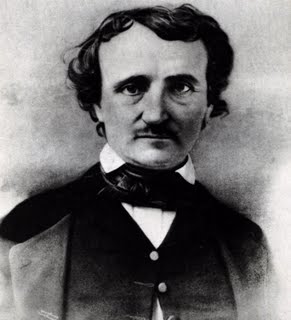
I think that is pretty good. Chatting recently with two Canadian men, one is 27 and the other in his late 30s I was incredulous that both did not know who Robert E. Lee was. But as memory of the distant past recedes to be replaced by memories of a not so distant past, I think I understand.
Because Rebecca was so against the work of Edgar Allan Poe I decided on the tack of hitting again but from an ancillary quarter, the film. I must report that the girls enjoyed the movie, Vincent Price played a lute and did not play a harpsichord. Rebecca pointed out, “Papi there was no blood oozing from the walls.” In what was supposed to be one of the scariest parts of the movie, Rebecca tried to block Lauren's vision. She became very angry and shouted, “I want to see this.”

Neither girls found the film scary at all.
4. Rebecca knows more about catalepsy than your average 12-year-old.
...and the deep and dank tarn at my feet closed sullenly and silently over the fragments of the "House of Usher".
The Fall of the House of Usher, Edgar Allan Poe, September 1839
A Gap in Poe's life

In 1955 my grandmother, my mother and I went to see John Ford’s The Long Gray Line with Tyrone Power, Maureen O’Hara and Ward Bond. Power plays an Irish immigrant who becomes a career non-commissioned officer at West Point. It was a terrific film then and has remained so in subsequent viewings.
I was 13 at the time and I distinctly remember that we saw the film at a beautiful movie house called Cine Metropolitan on Calle Independencia in Mexico City. This theater survived and is now just that, a theatre. I remember as we walked out on to Calle Independencia that my grandmother told my mother, “This film would suggest that the Americans see a war that is coming soon. The purpose of the film is to get viewers ready for war.” My grandmother was wrong as Vietnam happened quite a few years later. She was uncharacteristically wrong as she took her family away from the Philippines to the United States in the 20s when she saw no future for them as she was a young widow who because of her social status (high) would not be able to find a job in Manila. She got her job in New York and prospered until she saw the stock market crash coming and moved back to Manila. She foresaw the winds of war and moved again to Buenos Aires in 1939. She persuaded my mother to move to Mexico City before Perón fell when his minions were burning churches. We were safe in Mexico City when the Argentine Navy shelled and bombed Plaza de Mayo killing many civilians.
Since I was old enough to understand I can remember my mother and grandmother talking of issues that were adult issues. They either thought I would not understand or they thought I would.
And so I was left with that memory of an impending war that never came that afternoon outside the Cine Metropolitan as the memory of those long gray lines of marching soldiers and watching Maureen O’Hara with tears in her eyes glory at the special remembrance of her husband, the non-commissioned officer that was played by Tyrone Power. Only now do I see that this film was simply a military version of Goodbye Mr. Chips.
Some years before in the late 40s and early 50s my father and my mother had taken me to late shows in downtown Buenos Aires. Some of the films I remember vividly such as Beau Geste, Destination Moon and The Robe. I wonder if they ever worried that films had too much adult content. I think that to them this may have been irrelevant.
By the mid 50s my mother was handing me novels that she enjoyed and I began reading Frank G. Slaughter and Frank Yerby whose novels gave me my first indication of what birds and bees really did. She recommended Daphne Du Maurier and Spanish writer Salvador de Madariaga.
In spite of it all I do think I had a childhood and I played my fair share of pirate situations with wooden swords or war games with toy soldiers. I remember annoying my mother as I made the foxholes on her nice Buenos Aires lawns. She gave me money to buy caps for my Gene Autry Colt. At the same time I believe that she never did talk down to me as if I were only a child. I was something more.
Yesterday I took Lauren (all dolled up in a red dress and black patent leather shoes to a show at the Vancouver East Cultural Centre. The show featured a local rock band for youth called Duplex. They were a seriously good rock band that had lyrics that would satisfy both an adult and a child. An adult would have been impressed by the sophistication of their lyrics. Lauren appreciated such songs as Eat Your Salad and This Is How You Make a Sandwich. These shows begin at 7 and never run more than an hour. The Cultch has a special plan that makes it relatively inexpensive to take children 12 or over.
We arrived early as there was free pizza. The Cultch is attempting to draw out families to see live shows featuring theatre, music or dance. Perhaps if enough children go to enough shows a pattern will be set in their lives for an appreciation for live performances that go beyond juvenile shows on TV. This, I believe is a laudable effort.
Lauren would not have been caught dead dancing on the dance floor with the other children. She was sitting next to me looking like a child adult. I wonder if this is how I looked to my father and mother. Lauren noticed everything and told me “I had fun and I liked the pizza.”
Tonight I am going with Rebecca (12) to the Firehall Theatre to see Company Erasga’s modern dance performance, Adam-Eve/ Man-Woman featuring the choreography of Alvin Erasga Tolentino with dancers Alison Denham and Billy Marchenski.
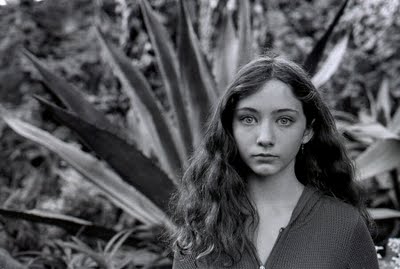
We know for sure that at least at the beginning both Denham and Marchenski will be firmly ensconced in Paradise with nary a fig leaf. Rebecca is a veteran of nudity in modern dance (she saw Slab when she was 6 or 7). I wonder if my mother would have taken me to such a performance had there been one in Buenos Aires at the time.
I wonder, and I wonder, but I do suspect that I am going in the right direction in my contribution to the education of Lauren and Rebecca. They giggle and they laugh but they know how to be serious when the situation dictates.
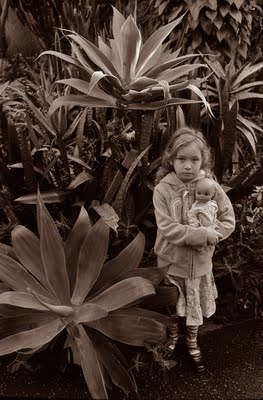
I saw little Lauren much like a surrogate Alice
She had one foot here (Vancouver) and one foot there
in that magic land that is Mexico
Agave attenuata , Bloedel Conservatory, Queen Elizabeth Park
Vancouver



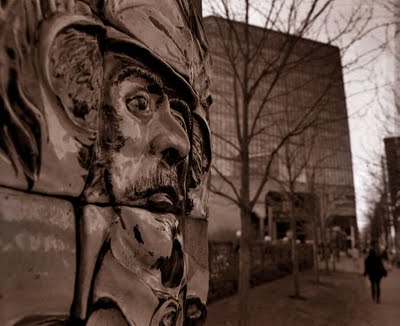
Edgar George Baynes was born at Braintree, Essex, England in 1870. He started his apprenticeship as a carpenter with Joseph Franklyn, "Coffin Maker & Cabinet Work", in a shop in Great Dunmow. When Franklyn and his family immigrated to Canada, Baynes came with them, arriving in Vancouver in April 1889. Baynes worked on a number of projects with another young carpenter, Will Horie; the two of them became friends and in 1893 established the contracting firm of Baynes & Horie. Baynes was married in 1899, and in 1906 built a large concrete block house at 1200 West Broadway in Vancouver that the family occupied for over fifty years.
Baynes & Horie were very successful, and prospered as the lower Mainland developed in the boom years before the First World War. The firm also designed many of these projects, including the Grosvenor Hotel (1913), which Baynes owned and managed until his death at the age of 87. In order to supply bricks for their many projects, in 1907 Baynes and Horie, along with Harold Burnet, formed the Port Haney Brick Works, which operated continuously for the next seventy years, providing drain tile for the Fraser Valley and clay partition tile as well as their trademark bricks.
From The Historic Communities of Maple Ridge
I took the picture above on a dreary day in December 1994. It was all that was left that proved that some years before there had been an understated and elegant hotel called the Grosvenor Hotel. It was on Howe Street almost at the corner with Robson. In the hotel there was a fashionable (for those with good taste like yours truly!) who frequented the African safari motif bar called Livingstone’s. It was low key and I vaguely remember that the food was good two. The hotel was demolished to make way what soon became Chapters and an expensive furniture store. Right behind is one of my favourite buildings in Vancouver that for some years was the headquarters of Kodak. They had a couple of floors which were linked by a beautiful spiral staircase. There were plants (and even trees) that made the floors look like the mini-hanging-gardens of Babylon. For a few years part of the ceramic plaque that marked the entrance to Livingston’s remained. It was like a baby tooth that is left dangling until your mother asks you to open your mouth and with no advance warning pulls it out.

One day the merry explorer was gone and soon gone from the memory of most of us. Sometimes when I walk on Howe I feel the presence of something. I know that in some way we humans can be like birds. We have embedded somewhere in our brain a little navigational antenna that tells us that there is a reference point, a little beacon, that we can use to guide us home. The reference point is gone and every day home seems to be less like home.

I have a vague memory about running into someone who told me of knowing who had taken the tiles that were missing from the right side of the picture. I am not sure if my memory serves me well or simply the tiles always had a missing side?

Today I spotted a pan with a couple of cups of two-day old white rice and suddenly I longed for arroz con leche.
Arroz con Leche
Arroz con leche,
Me quiero casar
con una señorita de San Nicolás,
que sepa bordar,
que sepa tejer,
que sepa abrir la puerta par ir a jugar.
Con ésta sí
con ésta no,
con esta señorita me caso yo.
Rice pudding
I want to marry
a señorita from San Nicolás,
she must know how to embroider
she must know how to knit,
she must know how to open the door to go out and play.
With this one yes
with this one no,
this señorita I will marry.
Since I can remember I knew the lyrics to this song. It is sung in Spain and everywhere else the Spaniards went. The Argentine version includes the town of San Nicolás which is in the Province of Buenos Aires.
Anbody who reads this might be surprised that I consider myself a connoisseur of the lowly postre (dessert) that many Latin American dismiss until they miss it.
The principal ingredients are rice, milk, sugar and a pinch of salt. Some add (I do) lemon or orange zest, vanilla (I do), a cinnamon stick (I do) and fewer still cardamom. Cardamon is a late ingredient for me as in India rice pudding is a specialty and cardamom is an important ingredient. I had not tried this Indian version until a couple of years ago. The cardamon somehow makes the cold pudding seem colder and ever more refreshing. I would never put raisins in my pudding. It would seem to me as uncouth as slathering catsup on French fries or smashing saltines over any kind of chowder. Juan Manuel Sanchez, my Argentine artist friend, made a killer rice pudding but he added slices of lemon which in my mind ruined it. The final touch to ice cold (not hot pudding for me) arroz con leche is a liberal sprinkling of cinnamon.
I have had arroz con leche in hundreds of places, in Argentina, Brazil, Uruguay, Perú, Mexico and Texas. Would you believe that the best rice pudding I ever had was on the Spirit of Vancouver ferry buffet on my way to Vancouver Island? I would kill for that recipe. Somehow the chef does not cook the milk too much as the pudding is a startling white concoction that contrasts most favorably to my yellowed version which I cook for hours so that the milk and the sugar caramelize.
It is 5pm and my pudding is cooling in the fridge. Rebecca spooned the pan and when I wasn’t watching helped herself to a bowl of the still hot dessert.
She might not yet know how to knit or embroider but Rebecca certainly could be that señorita from San Nicolás. She knows a good rice pudding when she sees one.
Both Rebecca and I will watch Lauren tonight and see if she will like it. This will be the ultimate test as Lauren is precisely demanding about that which she is willing to eat.
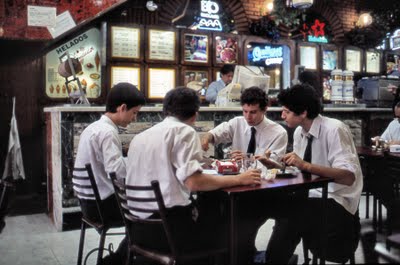
fiaca.
1. adj. coloq. Arg. Perezoso, indolente, desganado. U. t. c. s.
2. f. coloq. Arg. Pereza, desgana.
Real Academia Española © Todos los derechos reservados
Saturday night when Hilary was sitting by the fireplace I put on some Piazzolla. I picked my favourite Piazzolla piece which happens to be Hilary’s favourite. It is La Milonga del Angel. Hilary likes it because it is melancholy, soft and romantic. Just like I sometimes like to put myself in a melancholy mood Hilary explained to a curious Rebecca, “I like la Milonga del Angel because it makes me warmly sad. And sometimes, like in these dark and cold nights, that is a good thing.” Rosemary stared at my sad face and said, “You are going to have to go to Buenos Aires, even if it is by yourself.” She knows we don’t have the money for such a trip but she recognizes Argentine nostalgia when she sees it.
It did not get much better on Sunday. Dealing with a plumbing problem in my darkroom was not a pleasant way to spend the afternoon as Rosemary struggled with mastering the inserting of pictures into her Word invoice that she was working for the school course she is taking these months.
Luckily I remembered that Patricia and Robert (my neighbours) have been inviting me to watch the Italian Salvo Montalbano TV series (based on the novels by Sicilian author Andrea Camilleri) every Sunday at 7:30. Patricia purchased a box set in the US of 16 episodes that have been a hit not only in Italy but in Australia!
They are around one hour and forty minutes long and they are slow to move as there is a lot of character development.
For me the show strikes my inside in an intimate way. I saw one Montalbano episode two months ago at the downtown Istituto Italiano di Cultura. I went with my friend John Lekich who was charmed by the fact that we were sitting next to an elderly Italian couple who were kibitzing the events as they unfolded. Luca Zingaretti, below, plays the shortish and stubby Inspector Montalbano to perfection. Not that I knew that when I first saw that first episode as I had yet to read the books. But once I had read all of the 10 (that have been translated from the Italian) that first installment set the scene to make my vision of Zingaretti as the only Montalbano.

As I watched last night savouring a beautiful Marks & Spencer tea (Robert is English) I was struck how certain stuff could never be made by North Americans or even the English. This series unfolds slowly with the subtlety of expressions in the protagonists. I almost don’t need to read the English subtitles (aside from the fact that some of that Italian sounds a lot like Argentine Spanish!). I can almost read their thoughts. I feel how they feel. The actors are full of a humanity that goes beyond the skin deep beauty of the women of the show and the handsome and womanizing Mimi Augello played by Cesare Bocci, who is Montalbano’s closest assistant. I left the show and as I was walking home I missed the heat of Buenos Aires summers (almost as stifling as the Sicilian ones) and the loud gesturing of the characters mimicked by Argentines who are not necessarily Italian.
The episode we watch last night was called Montalbano’s Croquettes (Gli Arancini di Montalbano) and is was quite seasonal as the action happens between Christmas and New Year’s. When I saw Montalbano’s cleaning lady and cook, Natalia, place her roundly pyramidal rice croquettes into her deep fryer I was suddenly hit by nostalgia for the croquettes that our Mercedes (our live in cook and cleaning lady in Buenos Aires) made for us. I do believe that our Spanish for crunchy, crocante, is a tad more special and effective in describing what goes one in one's mouth when one bites on a rice croquette.
I was also hit by lethargy to do nothing when I got home. In Argentina I would have said, “Tengo fiaca.” This means I feel lazy. A lazy person in Argentina is a fiacudo. A nearby town to where Salvo Montalbano works is called Fiacca in the series. I investigated and found that Camilleri simply changed the real costal town of Sciacca to Fiacca and indeed in Italian fiacca means exactly what it means in Argentine Spanish.
I look forward to more Montalbano in those slow days after Christmas and before New Years. I have already looked up a few recipes for croquettes. My Argentine nostalgia makes me long a slice of pizza (the smell of an Argentine pizzeria is in my memory of scents) at Las Cuartetas on Calle Corrientes. I caught the foursome at Las Cuartetas some years ago as I ate my porción (slice) parado (standing up). It is mandatory to find a pizza joint where you can eat your pizza in a hurry. If it is really good you will linger, eat it slowly and wait for the next big pizza to be removed from the oven. It was a Las Cuartetas where my father took me after an evening of Westerns on Avenida Lavalle. It was at Las Cuartetas that my two daughters (when they were in their late teens and early 20s) made a pilgrimage. They told the man behind he counter that their father and grandfather had often come to eat a slice. They told him that as a sailor their father had come up from his office near the Naval Ministry to have his pizza. The man behind the counter placed two very large plates of sopa inglesa (translates to English soup). He told my daughters that it was on the house. Ale and Hilary did not know that sopa inglesa is an Italian/Argentine version of trifle and that it is usually loaded with brandy. They left holding on to each other for balance.
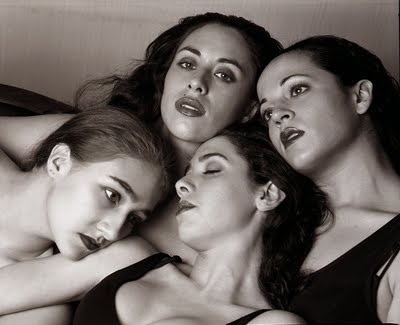
Today Saturday Rebecca, Lauren, Rosemary and I decided to visit the Bloedel Conservatory at Queen Elizabeth Park. Interesting things happened which were going to give me lots to write about. The children and Hilary were picked up late on Saturday night and I simply crashed telling myself I would write the Saturday blog on Sunday morning.
Today Sunday, afternoon, as I prepared myself to process the Tri-X roll of the Bloedel pictures of yesterday I was confronted with a darkroom leak (not a pesky one of light but the more messy one of unwanted water) . It is a perennial one caused by the plumbing industry which helps them create sales even in bad times. The “basket” device that is on both sides of a sink is made of stainless steel on the top side and aluminum on the bottom side. The aluminum corrodes every three to four years perhaps because of my darkroom chemicals. Another reason is that when you combine two metals closely, electricity and other factors do not inhibit corrosion. This is why just about any kitchen dishwasher manual will warn you about mixing metal cutlery with kitchen ware made of other metals.
The plumbing industry would help me avoid my usual week-end plumbing leaks by making that bottom basket out of stainless steel or even of hard plastic. Is this a conspiracy theory rant on my part? No, it is a simple observation. It is an excuse to wait until my sink is fixed (it is but I am waiting for my darkroom to dry a bit before I process that roll of Tri-X) before I place here the pictures of Lauren and Rebecca at the Bloedel Conservatory with that iconic Agave americana (a Mexican agave).
It will suffice for me to put here a portrait of two different sets of Argentine sisters. I only photographed the four and now they are in different places so I will probably not photograph them together again.
The picture of the sisters is justified in that I am citing a project of photographer Nicholas Nixon who in 1975 began taking pictures of his wife with her other three sisters. The project (he continued for at least 25 years) is called The Brown Sisters.
I have been fascinated by the Brown Sisters ever since I saw some of the pictures, and in particular the haunting one, 1982 Ipswich, Massachusetts, in the series many years ago at North Vancouver’s Presentation House.
I have been fascinated because I am a creature of routine. For the last 15 years I have woken up at 6:30 (there have been some exceptions) and I go downstairs to make breakfast for Rosemary and me. It is always the same breakfast. There have been some changes through the years. We used to have bacon on Sundays but we eliminated that custom four or five years ago. My daily tomato juice is affected by Rosemary being able to get it on sale. And the last four months Rosemary has suddenly shifted from hot cream of wheat to sliced bananas with brown sugar. This shift to bananas has been appreciated fully by my garden roses who esteem potassium as a growing supplement.
I feed the two cats. I open the front door and retrieve our Vancouver Sun and the New York Times. I take breakfast and the papers in a whicker tray upstairs where we have breakfast in bed and read the papers. No matter how stressful my life is (and here I can only write about myself since Rosemary does not seem to be able do disconnect her worry switch) I glory in the enjoying of my large mug of very strong and very good black tea, my Venice Bakery scissor rolls (freshly baked in my oven every morning) and the glass of juice while I see and read what has happened around the world. I love this kind of routine.
Routine was in my mind yesterday when I suggested, after lunch (Rebecca pointed out how she liked my cooking and Lauren had three helpings of the beans that I put in the oven with chopped onion, good Parmesan cheese and German Gruyere.) that we visit the birds at the Bloedel Consevatory and take our routine pictures by the agave. Rebecca protested, stamped her feet and had what in Mexico we would call a berrinche. She said that she was tired of doing the same things over and over, of coming to our house on Saturdays and seeing the same films about artists (we saw one on Rembrandt that evening that we all enjoyed). Then she shocked me with, “And then I go home where I feed the Guinea pigs, watch the same TV program and then go to bed and wake up the next day to to the same boring stuff.”
I could not believe it! Existential angst at 12!
In the fall of 1942 Sartre discovered Camus only weeks after sending off the completed manuscript of Being and Nothingness. Coincidentally at the time Sartre wrote a glowing and detailed 6,000-word essay to Camus’ The Stranger. In the essay, Sartre reads The Stranger alongside Camus’ The Myth of Sisyphus. Sartre wrote:
The absurd…resides neither in man nor in the world if you consider each separately. But since man's dominant characteristic is "being-in-the-world," the absurd is, in the end, an inseparable part of the human condition. Thus, the absurd is not, to begin with, the object of a mere idea; it is revealed to us in a doleful illumination. "Getting up, tram, four hours of work, meal, sleep, and Monday, Tuesday, Wednesday, Thursday, Friday, Saturday, in the same routine…," and then, suddenly, "the seeing collapses," and we find ourselves in a state of hopeless lucidity.
It almost sounded like Rebecca’s sudden angst about the uniformity of experience in her life. I was speechless and thought about it during our visit to the Bloedel Conservatory. Somehow she had settled down after demanding that I take her go garting instead of seeing the “same old birds”.
When we returned we had a chat about routine in the living room. I showed her the picture of Keely that had accidentally been double exposed with a unintended shot at the tea room where I had enjoyed the routine of conversations with my friend Abraham Rogatnick on Wednesdays.
I told Rebecca that routines are never really appreciated until they are lost. We should make it a point to study our routines and appreciate them as they happen and when they happen. She seemed to understand. For the time being it seems that Rebecca has overcome her existential angst.
As for Lauren, she said, "I like your cooking, Papi, but I don't want to eat your cole slaw." Lauren lives a life of absolutes. When will she get her first pangs of existential angst?
Thursday Routine

In the early 50s Bert Stern, 17, was working in the mailroom of Look Magazine. Delivering letters to the art director of the magazine’s promotion department he looked at a layout and blurted, “There’s a better way to do that.”
“Okay,” the amused art director told the upstart boy with no college, no designing training, “so do it.” Stern had found a teacher. The man’s name was Hershel Bramson. He hauled Stern up from his mailroom work to work as his assistant. Often the two would shut Bramson’s door to talk over a Coke and a handful of Oreo cookies; listening, cutting and pasting, Stern absorbed the elements of design that he now brings to every picture. “If you are going to put something on a very nice piece of clean paper,” Bramson used to tell him, “improve it. Don’t schlock it up.”
In 1955 under contract with Smirnoff Vodka Stern took an idea to the ad agency L.C. Gumbiner on how to convey the driest of martinis.
“What!”the president exclaimed. “Egypt? We don’t want to pay for your vacation.”
“Believe me, “Stern said, “in the middle of summer, Egypt is no vacation.”
“Why don’t you just build a pyramid here in a studio?”
“I don’t know how,” Stern said. “Besides, people will remember the ad if they hear I went all the way to Egypt for it. On top of that, they have an instinct that tells them when something is fake. We all know that pyramid.”
Petersen’s Masters of Contemporary Photography
Bert Stern: How To Turn Ideas Into Images
----------------------------------------------------------------------------------------------------------------------------------
Since the late 70s when I first purchased the above book about Bert Stern, I have been inspired by all of Stern’s principles for conceptualizing ideas in his head that lead to memorable images.
But I also worry about Stern’s belief in people having an instinct for what is real and for what is fake. Stern’s shot of the ultimate dry martini had the impact that could only happen in a "pre-special effects/Photoshop" era. Now just about anybody can seamlessly place a penguin in the arctic and a polar bear in the Antarctic. Nothing is seen as impossible anymore.
While I never went to Egypt and spent 2 weeks and 140 degree heat on the dessert sand I have my own photograph that today would certainly not be conceived and achieved in the same way.

It was sometime in the late 80s that Vancouver Magazine editor Malcolm Parry told me (it was a precise and startling mouthful), “Alex I want you to photograph a Porsche Carrera 4 and a Nissan 300ZX together and moving. I want you to use that Norman flash of yours. I want the cars to be red and I want you to be in one of the cars. I will drive the other.”
I thought Parry was crazy. Why the flash? Was there any purpose in it except to make my task that much more difficult? The startling glow of the resulting picture says something about Parry's talent for pre-visualization.
The first thing I did was to inspect both cars. It was our luck that the dealers had a red Porsche and a red Nissan. The 300ZX’s front end was all plastic. But the Porsche’s had a metal hook for towing it. I could design some sort of clamp that would hold a motorized Nikon FM-2 and Norman 200B light head and battery pack. I needed an extension to make the motor drive cord from the Nikon extend all the way to the interior of the car where I would be riding shotgun. I told Mac that the only way I could get the shot was to buy an expensive (I found a cheaper used one) Nikon fisheye lens.
For close to an hour we went up and down Georgia and the Cambie Street Bridge. We had problems with drivers that would position their cars so as to block my shooting angle. Sometime in the end of the day we had one of those dramatic skies and I got my shot.
Both the shots you see here have no manipulation except the manipulation of neurons in the mind. What will replace that, now that we can put penguins in the arctic and polar bears in the Antarctic?

Yesterday I taught my last studio classes for the season at Focal Point. The Contemporary Nude Portrait and Portraiture Through the Ages will meet one more time next Wednesday when we will critique the pictures my students took in the last two weeks. I will miss this bunch as both classes had very good photographers who showed that rare talent that is initiative.
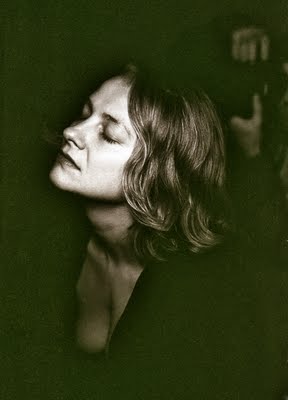
I had an ambivalent problem. I knew that we were going to have two of the best models at Focal Point and both of them would be in both classes. They are Keely end Yuliya. I have been feeling a bit down and out without my studio and watching my students shoot great models while I supervise. It would take up too much time and it would seem to me a bit unprofessional for me to also hook up to the studio lights and take my own pictures during class time. In the past I have occasionally shot with a small film camera with fast film and taken a few of what we in the business of photography call grab shots. I was ambivalent because I really wanted to take some pictures.
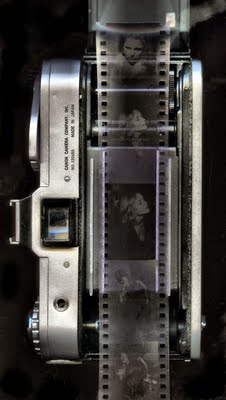
Gerrit te Hennepe, the lawyer of my of my recently deceased friend, Abraham Rogatnick, called me at noon and provided me (I did not know at the time of the call) for a justification to shoot some pictures of Keely and Yuliya. He called me to tell me he had found a couple of cameras in Abraham’s house and he wanted me to have them as I might find some use for them. I tried to explain to him that film cameras are now obsolete and mostly worthless and that I wanted to get rid of stuff and not acquire more of it.
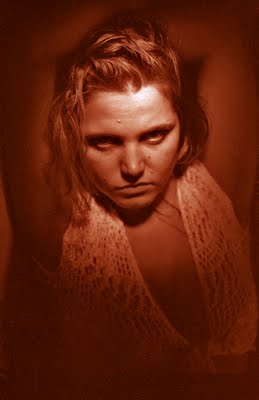
Te Hennepe insisted. I passed by his office which was conveniently a block away from Focal Point. He gave me a box with two cameras. One of them was a Malaysian made, electronic, film Minolta that did not bark because its battery was dead. The other camera was a rare gem that few people would know about.

It was a 1965 vintage Canon Pellix that had the innovation of a partly transparent mirror so that the usual noisy and jarring vibration flip of the mirror up (during the exposure) and then down (after the exposure) was eliminated as the mirror was fixed. Part of the light was diverted to the film and some of the rest to the viewfinder (not all that bright!). The camera failed in spite of this innovation. It was an expensive camera. The elegant mirror that did not move must have appealed to Abraham who had a Bauhaus feel for things as one of his teachers at Harvard was Walter Gropius. The Pellix came with two lenses for which Abraham must have paid a little fortune. One of them was a superb 50mm F-1.4 and the other a startlingly thin profiled “pancake” lens, a 38mm F-2.8. Years ago I had taken some clandestine shots in the Mexican Museum of anthropology (photography was and I believe still prohibited) by hiding a little Pentax MX with a pancake lens inside my jacket.
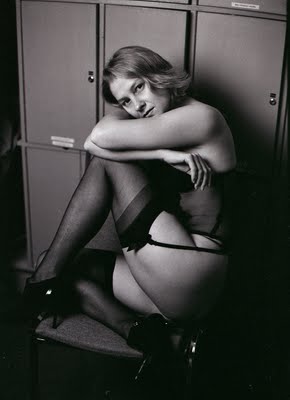
I taught the 2 to 5 nude class and controlled my urge to take pictures. During my break between 5 and 7 I went to the Tea Room across the street on 10th Avenue from Focal Point. Abraham and I used to sit there for at least an hour, sipping African tea and eating the fine pastry made by the Taiwanese/ Brazilian owner. I have been going there and missing Abraham a lot, particularly his intelligent discourse.
I made up my mind that I was going to test the Pellix on Yuliya and Keely. I practiced putting a roll of Tri-X a few times into the camera until I thought I had down pat the loading mechanism. I snapped the shutter a few times, removed the film and put it back and advanced it to my first exposure for the next class.

There is a cardinal rule of photography that stipulates that one should never use a camera for something important if the camera has not been used before. So, just to be sure I also loaded a marginally newer Nikon FM-2 with a roll of Tri-X.
I managed to shoot about 6 pictures with the Pellix. Focusing in a dark studio with the dim viewfinder was a challenge but I enjoyed the assertive but still quiet shutter. I took most of the pictures with the Nikon. I processed the film this morning. I had a pleasant surprise that was caused by some serendipity of which if I were to believe in things paranormal I would say that Abraham had a hand in it from the beyond.

Somehow when I snapped the shutter in the tea shop I caught my tea glass, the saucer and the spoon. When I photographed Keely with it, that image of was on her frame and I had a double exposure. The combination of Keely and the tea glass was delightful.
There were two more pictures in that Canon Pellix Roll that were killers. One is an almost profile of Yuliya and the other is the nicely scary picture of Keely that I scanned. For drama I added a red and yellow toning via Photoshop. The rest of the pictures are the more predictable ones taken with my Nikon FM-2. I believe that I just might show off to my student’s in next week’s critique!
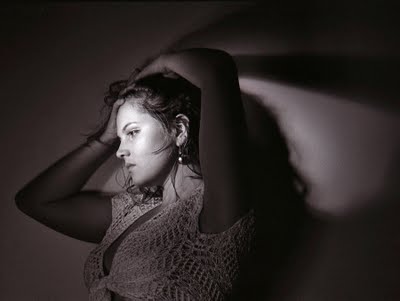
Abraham would have told me, “You should take pictures when you can even if you are the teacher. If you don’t, you're a schmuck.” Thanks to Abraham and his sophisticated klunker I feel as if I were a 20 year-old, all excited about photography as I feast my eyes on the pictures of Keely and Yuliya.
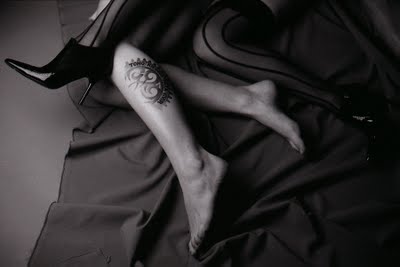
I sent the Keely and the tea picture to Gerrit who replied:
Dear Alex
Thanks for sending me to first two exposures of your use of the Pellix.............Abraham would have undoubtedly have appreciated the unintended yet creative juxtaposition of the two images.
It is a wonderful picture - the model is beautiful and expressive - and will remind me of you and Abraham........and makes me pleased that you have the camera(s)
Were you working on chiaroscuro?
Gerrit
Technical Information: All pictures were taken either by a Nikon FM-2 with a 50mm F-1.4 or a Canon Pellix with a 50mm F-1.4. I shot Kodak Tri-X pushed to 800 ISO which I processed in Kodak HC-110 Dil 1/39 for 6 minutes 45 seconds.

This is a pleasant story that begins with a very serious Argentine woman. Nilda Crivelli came to Vancouver this past June as a delegate to the Vancouver World Rose Convention. She was a former president of the Argentine Rose Society. She was formal as many Argentines can sometimes be. I invited her to our rose garden and then we visited Vancouver rosarian Janet Wood with my granddaughter Rebecca. By the end of the day we were caught on one of those bicycle Fridays and we did not move, from our Cardero and Georgia spot for a whole hour. By then Crivelli had lost her Argentine formality and she was laughing as I secretely swore at the cyclists who blocked our way.
A few months later she e-mailed me to tell me she had suggested that Martín Flores (a director and playwright of the avant garde in Buenos Aires) look me up when he arrived on an interesting assignment in Vancouver. Flores did contact me and I had him for dinner. It was a treat to be able to converse (over a delicious bottle of Argentine Torrontés wine)in Argentine Spanish with the younger Argentine man. I suggested we meet for a night of theatre at UBC’s Telus Theatre. My friend writer and actor C. C. Humphreys was tackling the principal protagonist of Henrik Ibsen’s The Master Builder. The play was a tad heavy and serious for us but I told Martín that in Vancouver we had a tradition of being able to go back stage to talk to the actors. That cheered us up. We went backstage and caught C.C. Humphreys in the shower. He did allow us to appear with him in his almost near naked Ibsen persona and told me, “I gather this will appear in some blog of yours.”
For me the evening was one that I have been digesting since. I had somehow had never seen an Ibsen play. It was a strange experience. My first impression was that Ibsen did not translate too well into the 21st century. Now I am not so sure and I think, that thanks to C.C. Humphreys I am ready for Hedda Gabler.
Martín Flores explained to me that by some quirk of fate he had been invited to Vancouver to direct the students of the Eric Hamber Secondary School Theatre Department (Theatre Hamber).
I decided to take Rebecca to the opening night, yesterday Tuesday and alas I got my time wrong and we arrived at the intermission. This mistake ended up being a blessing in disguise as I will explain below.
Naked, written by the 12 students in the play, and only directed by Martín Flores (As he modestly explained his contribution in what if you happen to know Argentines is most uncharacteristic!) is a terrific set of 12 monologues (with some limited interaction of the other players). The actors reveal up front on a mike some of their pet fears: The One In Love, The One Who Cannot Dancer, The One Who Can’t Stand to be Touched, The One Who Fears Being Buried Alive (extremely Edgar Allan Poeish).
In my years of going to terrible high school plays (so as not to offend my daughters) Naked was professional, terrific and best of all my laughs and Rebecca’s were good chicken soup to my lately bluish insides.
The man singly responsible for the laughs was John Lee (The One who is Afraid of Many Things), see below in picture with Rebecca and Martin Flores. He has all the makings of natural born stand-up comedian who will make a fortune if his plans to become a nuclear physicist should fail. Lee the man who fears pants that fit and gave us an explanation of why the Chinese might not be able to drive (in involves unicorns and giraffes) delighted us and made Rebecca and I decide that we should return to see the play (all of it!) tomorrow. We will bring along her mother. I look forward to all that laughing.
But it wasn’t all laughs. Sarah Trolland (The One in Love) gave a crescendo of a performance where she updated with panache (my view on it) Elizabeth Barrett Browning’s How Do I Love Thee? By the end of her monologue I could see tears in her eyes.
As I understand it, her friend Justin Somjen (a precocious student of mine at Focal Point) shed some tears the very same night we were there. We plan to do some more laughing tomorrow.
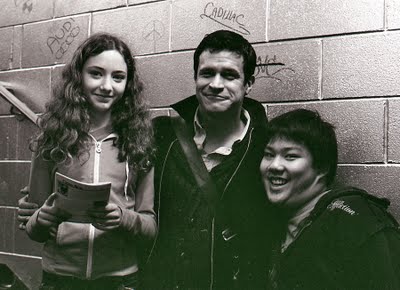
Naked, until December 4th, 7pm (doors open at 6:30) Admission $6.00 Directed by Martín Flores Cárdenas with:
Zahra Cully, Alex Dee, (I thought he was cute and when I asked Rebecca she blushed.), Andrew Duffy, Pamela Kennedy, Krystyna Kozlowski, Jon Lee, Ellen MacNevin, Mihajlo Todorovic, Sarah Trolland, Stephen Wong, Holly Zhou.
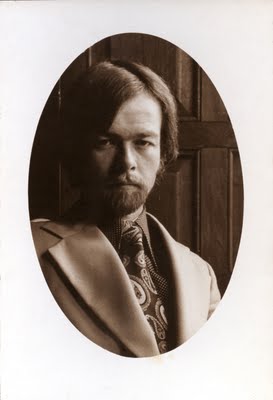
At the last possible moment on Monday I found out I had to teach for 6 hours on Tuesday. That put my blog writing on the back burner until last night (Tuesday) when I managed to find a subject to write about and did so in short minutes. I went to bed with pangs of regret for having thrown away the negatives of La Señorita.
This morning I woke up to a pleasant and interesting e-mail communication from Parksville, BC professional photographer Gordon Lafleur who wrote:
I find it interesting and charming that the gaze of the lovely Mexican woman on today's entry is the same gaze that appears in most of your grandaughters’ photos.
It would seem that Lafleur caught a quirk of mine that I was too close to notice. The pattern was set back then. It was in that unintended class that I taught yesterday at Van Arts (a brand new set of students who all seem to be passionate for photography) that I told my students that for years I have been taking pictures of Rebecca and everybody else, gazing at my camera seriously. I told them that I had borrowed, adapted and made my own the same serious gaze capture that Julia Margaret Cameron so eloquently used in her portraiture. The portraits of Alice Liddell (taken by Cameron when Liddell was an adult) when she seriously posed as a little girl quasi adult for the Reverend Charles Lutwidge Dodgson influenced my approach as did the half century stretch of portraiture by German photographer August Sander.

There was a fundamental reason for the seriousness of early photographic portraiture. To begin with in the painting of portraits few (except for La Joconde) would sit and smile for the length of time needed to render the painting. Serious portraits were the norm. With the advent of photographic portraiture, photographers were plagued with slow lenses and even slower silver sensitized materials. At first the best subjects for these photographers were dead people. Only corpses could remain at rest and not move during those lengthy many minute exposures. As exposures began to shorten devices were still needed to keep portrait subjects at rest. Metal bars attached to their backs and even neck braces were used. In the length of a long exposure the closing of eyes were inconsequential. As the exposures shortened the closing of eyes became a problem.

It was easier, then, for people to gaze, with no smile into the distance.
As I sifted through that little leather-bound album of portraits that I had used as a portfolio to get work in the Mexico City of 1974 I found the portrait of my Yorkshire-born friend Andrew Taylor who is the godfather of my eldest daughter Ale. As he gazed seriously into my camera he almost looks like an American Civil War general. This is not an accident. The portraits of that civil war that I saw inside an American Heritage book at the USIS Lincoln Library in Buenos Aires in the early 50s were the ones that awoke my interest in photography. Those civil war generals, as I gazed on them in that first glimpse around 1951 or 52 looked to me like men that I might have seen that same day walking on Calle Florida.
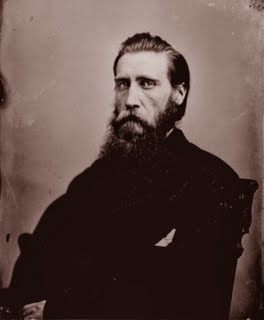
Andrew Taylor with his wild and wide psychedelic tie looks to me like an ever so slightly less-crazed General William Tecumseh Sherman about to embark on his destructive march to the sea.
In order of appearance:
1. Andrew Taylor, Esquire
2. General William Tecumseh Sherman
3. General Ulysses S. Grant
4. General John B. Hood (of the Confederate Army)

I like to look at the back page of the NY Times’ Sunday Book Review. The page is always an ad for Bauman Rare Books and I enjoy looking at the greatly enhanced prices of books that were once commonplace but as years pass few remain. It is that which explains the inflated prices.
As an example there is Charles Lindbergh We: The Flier’s Own Story 1927. First edition, boldly signed by Lindbergh (bold by advertiser) $5200.
It would seem that enough time has elapsed to erase from the many the memory of the fact that Lindbergh was a Nazi sympathizer. Being Nazi sympathizers has taken the shine off the erstwhile royals, the Duke and the Duchess of Windsor. Not too many people would now bid for original rolls of toilet paper from the bathroom of their suite in New York City.
No such bad reputation attaches to the literary achievement of Charles Dickens. The ad in Bauman’s Rare Books reads: A Christmas Carol 1843 “The one great Christmas myth of modern literature.” First edition, with four hand-coloured engraved plates, finely bound in full morocco-guilt, $15,000.
I remember passing by Bauman Rare Books in one of my trips to NY City. It is on Madison Avenue. I peaked through the windows and realized that I would have never been allowed entry, in my jeans and longish hair. But I did dream then.
Alas I no longer dream about going into Bauman Rare Books.
Ernest Hemingway The Old Man and the Sea 1952 “Man is not made for defeat.” First edition of Hemingway’s classic $3500.
I went into one of my lawyer’s book cases in the living room and took out my own personal copy of The Old Man and the Sea. It is a first edition but is worth less because it has no dust jacket and it is signed by its former owner, my neighbour’s son Carter Smith. Hemingway’s book came our way with a 100 year old Chickering baby grand when the Smiths had to move. Mr. Claire Smith was forgetting who he was.
I showed the book to Rosemary who said, “We might have to sell it.” At one time I would have been terribly upset – not anymore. I think I crossed a bookish Rubicon a month ago when I decided I was not going to buy any more books and that I was going to depend solely on the excellent stacks of the Vancouver Public Library.
Even before my decision I had already started a campaign of buying fewer books. I bought fewer expensive-just-out books this year and depended more on Chapters’ remainder section. And indication of that is that for the first time in my memory, in the NY Times Book Review annual (today) list of the 10 best books of 2009 there is not one in the list (five non-fiction, five fiction) that I have already read or wish to read. The only possible candidate would have been Raymond Carver – A Writer’s Life by Carol Sklenicka. I have a feeling that this good book would probably depress me as Carver’s life was not a happy one. One thing I do not need now is a book that depresses me.

As I look around my house and the thousands of books I realize that sooner or later many, if not almost all, have to go before I go. My friend, bookmeister Robert Blackwood, who suffered a severe stroke recently, once told me that there are some books that one does not want to read again. He divides his extensive book collection in such a parameter. As much as I loved the books of Tony Hillerman I know I never want to re-read any of them (except his 1971 Fly On the Wall which is a non American Indian themed novel). I can see getting rid of them. The problem is that few used books stores these days are willing to hand out cash as they themselves are going through troubled times as people switch to flat screen TVs and reality shows. Books are slowly becoming worthless, that is except at Bauman Rare Books.
It is important for me to understand that the value that I give to my own books is a value that I can measure by the pleasure they have given me in entertainment and knowledge. Even if I were to fling them into a dumpster their real value would not be diminished. Alive I am proof of it.
And, believe it or not, I have been tempted buy one book (two volumes) from Bauman Rare Books that at one time was almost within my reach. My Vancouver Public Library only has it listed as a Gutenberg Library electronic asset. This means that I can download it to my computer and then print it out in hundreds of pages. I will buy (if I do) from Abe Books. The book in question is as listed by Bauman Rare Books is:
Ulysses S. Grant's Personal Memoirs, first edition. Grant's classic Civil War autobiography ranks among the greatest military memoirs in history, two volumes in original cloth, $750.
My Scary Girls Weren't Scared
Saturday, December 12, 2009

In the compression of memory that might just be its normal course, as one gets old, is my memory of two films I saw in 1960. One of them was supposed to be my first dirty movie and I dragged my roommates from the Catholic boarding school St. Edward's in Austin, Texas. In spite of its title, The Virgin Spring was not a “dirty” movie but the first Ingmar Bergman film I saw. The other film was The House of Usher, shortened from Edgar Allan Poe's story title, The Fall of the House of Usher. As I sat in the little movie house on Congress Avenue I could never have suspected that I would one day photograph both its star, Vincent Price and its noted producer Samuel Z. Arkoff.
In my memory was the vision of Vincent Price (as Roderick Usher) playing a harpsichord. The other vision was of Technicolor blood oozing from the walls. I was 18 years old and the film scared me. It had to. It left that lasting impression considering that I went to the movies much more then. Yet I only remember those two, the dirty film that wasn't and The House of Usher.
Last week I read Edgar Allan Poe’s The Premature Burial after lunch to Rosemary and Rebecca. They both hated it. Rebecca tried to stop me, telling me that if I persisted she was going to pull out her hair. This she did, to my astonishment. I did not think it appropriate to quote Poe, "Should you ever be drowned or hung, be sure and make a note of your sensations." Rebecca objected to all the words she did not know the meaning of but left the table knowing three facts:
1. Edgar Allan Poe was American.
2. He was an author.
3. He was born in 1809.

I think that is pretty good. Chatting recently with two Canadian men, one is 27 and the other in his late 30s I was incredulous that both did not know who Robert E. Lee was. But as memory of the distant past recedes to be replaced by memories of a not so distant past, I think I understand.
Because Rebecca was so against the work of Edgar Allan Poe I decided on the tack of hitting again but from an ancillary quarter, the film. I must report that the girls enjoyed the movie, Vincent Price played a lute and did not play a harpsichord. Rebecca pointed out, “Papi there was no blood oozing from the walls.” In what was supposed to be one of the scariest parts of the movie, Rebecca tried to block Lauren's vision. She became very angry and shouted, “I want to see this.”

Neither girls found the film scary at all.
4. Rebecca knows more about catalepsy than your average 12-year-old.
...and the deep and dank tarn at my feet closed sullenly and silently over the fragments of the "House of Usher".
The Fall of the House of Usher, Edgar Allan Poe, September 1839
A Gap in Poe's life
Seriously Serious Children
Friday, December 11, 2009

In 1955 my grandmother, my mother and I went to see John Ford’s The Long Gray Line with Tyrone Power, Maureen O’Hara and Ward Bond. Power plays an Irish immigrant who becomes a career non-commissioned officer at West Point. It was a terrific film then and has remained so in subsequent viewings.
I was 13 at the time and I distinctly remember that we saw the film at a beautiful movie house called Cine Metropolitan on Calle Independencia in Mexico City. This theater survived and is now just that, a theatre. I remember as we walked out on to Calle Independencia that my grandmother told my mother, “This film would suggest that the Americans see a war that is coming soon. The purpose of the film is to get viewers ready for war.” My grandmother was wrong as Vietnam happened quite a few years later. She was uncharacteristically wrong as she took her family away from the Philippines to the United States in the 20s when she saw no future for them as she was a young widow who because of her social status (high) would not be able to find a job in Manila. She got her job in New York and prospered until she saw the stock market crash coming and moved back to Manila. She foresaw the winds of war and moved again to Buenos Aires in 1939. She persuaded my mother to move to Mexico City before Perón fell when his minions were burning churches. We were safe in Mexico City when the Argentine Navy shelled and bombed Plaza de Mayo killing many civilians.
Since I was old enough to understand I can remember my mother and grandmother talking of issues that were adult issues. They either thought I would not understand or they thought I would.
And so I was left with that memory of an impending war that never came that afternoon outside the Cine Metropolitan as the memory of those long gray lines of marching soldiers and watching Maureen O’Hara with tears in her eyes glory at the special remembrance of her husband, the non-commissioned officer that was played by Tyrone Power. Only now do I see that this film was simply a military version of Goodbye Mr. Chips.
Some years before in the late 40s and early 50s my father and my mother had taken me to late shows in downtown Buenos Aires. Some of the films I remember vividly such as Beau Geste, Destination Moon and The Robe. I wonder if they ever worried that films had too much adult content. I think that to them this may have been irrelevant.
By the mid 50s my mother was handing me novels that she enjoyed and I began reading Frank G. Slaughter and Frank Yerby whose novels gave me my first indication of what birds and bees really did. She recommended Daphne Du Maurier and Spanish writer Salvador de Madariaga.
In spite of it all I do think I had a childhood and I played my fair share of pirate situations with wooden swords or war games with toy soldiers. I remember annoying my mother as I made the foxholes on her nice Buenos Aires lawns. She gave me money to buy caps for my Gene Autry Colt. At the same time I believe that she never did talk down to me as if I were only a child. I was something more.
Yesterday I took Lauren (all dolled up in a red dress and black patent leather shoes to a show at the Vancouver East Cultural Centre. The show featured a local rock band for youth called Duplex. They were a seriously good rock band that had lyrics that would satisfy both an adult and a child. An adult would have been impressed by the sophistication of their lyrics. Lauren appreciated such songs as Eat Your Salad and This Is How You Make a Sandwich. These shows begin at 7 and never run more than an hour. The Cultch has a special plan that makes it relatively inexpensive to take children 12 or over.
We arrived early as there was free pizza. The Cultch is attempting to draw out families to see live shows featuring theatre, music or dance. Perhaps if enough children go to enough shows a pattern will be set in their lives for an appreciation for live performances that go beyond juvenile shows on TV. This, I believe is a laudable effort.
Lauren would not have been caught dead dancing on the dance floor with the other children. She was sitting next to me looking like a child adult. I wonder if this is how I looked to my father and mother. Lauren noticed everything and told me “I had fun and I liked the pizza.”
Tonight I am going with Rebecca (12) to the Firehall Theatre to see Company Erasga’s modern dance performance, Adam-Eve/ Man-Woman featuring the choreography of Alvin Erasga Tolentino with dancers Alison Denham and Billy Marchenski.

We know for sure that at least at the beginning both Denham and Marchenski will be firmly ensconced in Paradise with nary a fig leaf. Rebecca is a veteran of nudity in modern dance (she saw Slab when she was 6 or 7). I wonder if my mother would have taken me to such a performance had there been one in Buenos Aires at the time.
I wonder, and I wonder, but I do suspect that I am going in the right direction in my contribution to the education of Lauren and Rebecca. They giggle and they laugh but they know how to be serious when the situation dictates.
Agave attenuata, Lauren Stewart & Emily
Thursday, December 10, 2009

I saw little Lauren much like a surrogate Alice
She had one foot here (Vancouver) and one foot there
in that magic land that is Mexico
Agave attenuata - Bloedel Conservatory
Wednesday, December 09, 2009
Agave attenuata , Bloedel Conservatory, Queen Elizabeth Park
Vancouver



Urban Avian Navigation
Tuesday, December 08, 2009

Edgar George Baynes was born at Braintree, Essex, England in 1870. He started his apprenticeship as a carpenter with Joseph Franklyn, "Coffin Maker & Cabinet Work", in a shop in Great Dunmow. When Franklyn and his family immigrated to Canada, Baynes came with them, arriving in Vancouver in April 1889. Baynes worked on a number of projects with another young carpenter, Will Horie; the two of them became friends and in 1893 established the contracting firm of Baynes & Horie. Baynes was married in 1899, and in 1906 built a large concrete block house at 1200 West Broadway in Vancouver that the family occupied for over fifty years.
Baynes & Horie were very successful, and prospered as the lower Mainland developed in the boom years before the First World War. The firm also designed many of these projects, including the Grosvenor Hotel (1913), which Baynes owned and managed until his death at the age of 87. In order to supply bricks for their many projects, in 1907 Baynes and Horie, along with Harold Burnet, formed the Port Haney Brick Works, which operated continuously for the next seventy years, providing drain tile for the Fraser Valley and clay partition tile as well as their trademark bricks.
From The Historic Communities of Maple Ridge
I took the picture above on a dreary day in December 1994. It was all that was left that proved that some years before there had been an understated and elegant hotel called the Grosvenor Hotel. It was on Howe Street almost at the corner with Robson. In the hotel there was a fashionable (for those with good taste like yours truly!) who frequented the African safari motif bar called Livingstone’s. It was low key and I vaguely remember that the food was good two. The hotel was demolished to make way what soon became Chapters and an expensive furniture store. Right behind is one of my favourite buildings in Vancouver that for some years was the headquarters of Kodak. They had a couple of floors which were linked by a beautiful spiral staircase. There were plants (and even trees) that made the floors look like the mini-hanging-gardens of Babylon. For a few years part of the ceramic plaque that marked the entrance to Livingston’s remained. It was like a baby tooth that is left dangling until your mother asks you to open your mouth and with no advance warning pulls it out.

One day the merry explorer was gone and soon gone from the memory of most of us. Sometimes when I walk on Howe I feel the presence of something. I know that in some way we humans can be like birds. We have embedded somewhere in our brain a little navigational antenna that tells us that there is a reference point, a little beacon, that we can use to guide us home. The reference point is gone and every day home seems to be less like home.

I have a vague memory about running into someone who told me of knowing who had taken the tiles that were missing from the right side of the picture. I am not sure if my memory serves me well or simply the tiles always had a missing side?
Arroz Con Leche & The Señorita From San Nicolás
Monday, December 07, 2009

Today I spotted a pan with a couple of cups of two-day old white rice and suddenly I longed for arroz con leche.
Arroz con Leche
Arroz con leche,
Me quiero casar
con una señorita de San Nicolás,
que sepa bordar,
que sepa tejer,
que sepa abrir la puerta par ir a jugar.
Con ésta sí
con ésta no,
con esta señorita me caso yo.
Rice pudding
I want to marry
a señorita from San Nicolás,
she must know how to embroider
she must know how to knit,
she must know how to open the door to go out and play.
With this one yes
with this one no,
this señorita I will marry.
Since I can remember I knew the lyrics to this song. It is sung in Spain and everywhere else the Spaniards went. The Argentine version includes the town of San Nicolás which is in the Province of Buenos Aires.
Anbody who reads this might be surprised that I consider myself a connoisseur of the lowly postre (dessert) that many Latin American dismiss until they miss it.
The principal ingredients are rice, milk, sugar and a pinch of salt. Some add (I do) lemon or orange zest, vanilla (I do), a cinnamon stick (I do) and fewer still cardamom. Cardamon is a late ingredient for me as in India rice pudding is a specialty and cardamom is an important ingredient. I had not tried this Indian version until a couple of years ago. The cardamon somehow makes the cold pudding seem colder and ever more refreshing. I would never put raisins in my pudding. It would seem to me as uncouth as slathering catsup on French fries or smashing saltines over any kind of chowder. Juan Manuel Sanchez, my Argentine artist friend, made a killer rice pudding but he added slices of lemon which in my mind ruined it. The final touch to ice cold (not hot pudding for me) arroz con leche is a liberal sprinkling of cinnamon.
I have had arroz con leche in hundreds of places, in Argentina, Brazil, Uruguay, Perú, Mexico and Texas. Would you believe that the best rice pudding I ever had was on the Spirit of Vancouver ferry buffet on my way to Vancouver Island? I would kill for that recipe. Somehow the chef does not cook the milk too much as the pudding is a startling white concoction that contrasts most favorably to my yellowed version which I cook for hours so that the milk and the sugar caramelize.
It is 5pm and my pudding is cooling in the fridge. Rebecca spooned the pan and when I wasn’t watching helped herself to a bowl of the still hot dessert.
She might not yet know how to knit or embroider but Rebecca certainly could be that señorita from San Nicolás. She knows a good rice pudding when she sees one.
Both Rebecca and I will watch Lauren tonight and see if she will like it. This will be the ultimate test as Lauren is precisely demanding about that which she is willing to eat.
The Exquisite Lethargy & Melancholy Of Fiacca
Sunday, December 06, 2009

fiaca.
1. adj. coloq. Arg. Perezoso, indolente, desganado. U. t. c. s.
2. f. coloq. Arg. Pereza, desgana.
Real Academia Española © Todos los derechos reservados
Saturday night when Hilary was sitting by the fireplace I put on some Piazzolla. I picked my favourite Piazzolla piece which happens to be Hilary’s favourite. It is La Milonga del Angel. Hilary likes it because it is melancholy, soft and romantic. Just like I sometimes like to put myself in a melancholy mood Hilary explained to a curious Rebecca, “I like la Milonga del Angel because it makes me warmly sad. And sometimes, like in these dark and cold nights, that is a good thing.” Rosemary stared at my sad face and said, “You are going to have to go to Buenos Aires, even if it is by yourself.” She knows we don’t have the money for such a trip but she recognizes Argentine nostalgia when she sees it.
It did not get much better on Sunday. Dealing with a plumbing problem in my darkroom was not a pleasant way to spend the afternoon as Rosemary struggled with mastering the inserting of pictures into her Word invoice that she was working for the school course she is taking these months.
Luckily I remembered that Patricia and Robert (my neighbours) have been inviting me to watch the Italian Salvo Montalbano TV series (based on the novels by Sicilian author Andrea Camilleri) every Sunday at 7:30. Patricia purchased a box set in the US of 16 episodes that have been a hit not only in Italy but in Australia!
They are around one hour and forty minutes long and they are slow to move as there is a lot of character development.
For me the show strikes my inside in an intimate way. I saw one Montalbano episode two months ago at the downtown Istituto Italiano di Cultura. I went with my friend John Lekich who was charmed by the fact that we were sitting next to an elderly Italian couple who were kibitzing the events as they unfolded. Luca Zingaretti, below, plays the shortish and stubby Inspector Montalbano to perfection. Not that I knew that when I first saw that first episode as I had yet to read the books. But once I had read all of the 10 (that have been translated from the Italian) that first installment set the scene to make my vision of Zingaretti as the only Montalbano.

As I watched last night savouring a beautiful Marks & Spencer tea (Robert is English) I was struck how certain stuff could never be made by North Americans or even the English. This series unfolds slowly with the subtlety of expressions in the protagonists. I almost don’t need to read the English subtitles (aside from the fact that some of that Italian sounds a lot like Argentine Spanish!). I can almost read their thoughts. I feel how they feel. The actors are full of a humanity that goes beyond the skin deep beauty of the women of the show and the handsome and womanizing Mimi Augello played by Cesare Bocci, who is Montalbano’s closest assistant. I left the show and as I was walking home I missed the heat of Buenos Aires summers (almost as stifling as the Sicilian ones) and the loud gesturing of the characters mimicked by Argentines who are not necessarily Italian.
The episode we watch last night was called Montalbano’s Croquettes (Gli Arancini di Montalbano) and is was quite seasonal as the action happens between Christmas and New Year’s. When I saw Montalbano’s cleaning lady and cook, Natalia, place her roundly pyramidal rice croquettes into her deep fryer I was suddenly hit by nostalgia for the croquettes that our Mercedes (our live in cook and cleaning lady in Buenos Aires) made for us. I do believe that our Spanish for crunchy, crocante, is a tad more special and effective in describing what goes one in one's mouth when one bites on a rice croquette.
I was also hit by lethargy to do nothing when I got home. In Argentina I would have said, “Tengo fiaca.” This means I feel lazy. A lazy person in Argentina is a fiacudo. A nearby town to where Salvo Montalbano works is called Fiacca in the series. I investigated and found that Camilleri simply changed the real costal town of Sciacca to Fiacca and indeed in Italian fiacca means exactly what it means in Argentine Spanish.
I look forward to more Montalbano in those slow days after Christmas and before New Years. I have already looked up a few recipes for croquettes. My Argentine nostalgia makes me long a slice of pizza (the smell of an Argentine pizzeria is in my memory of scents) at Las Cuartetas on Calle Corrientes. I caught the foursome at Las Cuartetas some years ago as I ate my porción (slice) parado (standing up). It is mandatory to find a pizza joint where you can eat your pizza in a hurry. If it is really good you will linger, eat it slowly and wait for the next big pizza to be removed from the oven. It was a Las Cuartetas where my father took me after an evening of Westerns on Avenida Lavalle. It was at Las Cuartetas that my two daughters (when they were in their late teens and early 20s) made a pilgrimage. They told the man behind he counter that their father and grandfather had often come to eat a slice. They told him that as a sailor their father had come up from his office near the Naval Ministry to have his pizza. The man behind the counter placed two very large plates of sopa inglesa (translates to English soup). He told my daughters that it was on the house. Ale and Hilary did not know that sopa inglesa is an Italian/Argentine version of trifle and that it is usually loaded with brandy. They left holding on to each other for balance.
Cole Slaw & Existential Angst At 12
Saturday, December 05, 2009

Today Saturday Rebecca, Lauren, Rosemary and I decided to visit the Bloedel Conservatory at Queen Elizabeth Park. Interesting things happened which were going to give me lots to write about. The children and Hilary were picked up late on Saturday night and I simply crashed telling myself I would write the Saturday blog on Sunday morning.
Today Sunday, afternoon, as I prepared myself to process the Tri-X roll of the Bloedel pictures of yesterday I was confronted with a darkroom leak (not a pesky one of light but the more messy one of unwanted water) . It is a perennial one caused by the plumbing industry which helps them create sales even in bad times. The “basket” device that is on both sides of a sink is made of stainless steel on the top side and aluminum on the bottom side. The aluminum corrodes every three to four years perhaps because of my darkroom chemicals. Another reason is that when you combine two metals closely, electricity and other factors do not inhibit corrosion. This is why just about any kitchen dishwasher manual will warn you about mixing metal cutlery with kitchen ware made of other metals.
The plumbing industry would help me avoid my usual week-end plumbing leaks by making that bottom basket out of stainless steel or even of hard plastic. Is this a conspiracy theory rant on my part? No, it is a simple observation. It is an excuse to wait until my sink is fixed (it is but I am waiting for my darkroom to dry a bit before I process that roll of Tri-X) before I place here the pictures of Lauren and Rebecca at the Bloedel Conservatory with that iconic Agave americana (a Mexican agave).
It will suffice for me to put here a portrait of two different sets of Argentine sisters. I only photographed the four and now they are in different places so I will probably not photograph them together again.
The picture of the sisters is justified in that I am citing a project of photographer Nicholas Nixon who in 1975 began taking pictures of his wife with her other three sisters. The project (he continued for at least 25 years) is called The Brown Sisters.
I have been fascinated by the Brown Sisters ever since I saw some of the pictures, and in particular the haunting one, 1982 Ipswich, Massachusetts, in the series many years ago at North Vancouver’s Presentation House.
I have been fascinated because I am a creature of routine. For the last 15 years I have woken up at 6:30 (there have been some exceptions) and I go downstairs to make breakfast for Rosemary and me. It is always the same breakfast. There have been some changes through the years. We used to have bacon on Sundays but we eliminated that custom four or five years ago. My daily tomato juice is affected by Rosemary being able to get it on sale. And the last four months Rosemary has suddenly shifted from hot cream of wheat to sliced bananas with brown sugar. This shift to bananas has been appreciated fully by my garden roses who esteem potassium as a growing supplement.
I feed the two cats. I open the front door and retrieve our Vancouver Sun and the New York Times. I take breakfast and the papers in a whicker tray upstairs where we have breakfast in bed and read the papers. No matter how stressful my life is (and here I can only write about myself since Rosemary does not seem to be able do disconnect her worry switch) I glory in the enjoying of my large mug of very strong and very good black tea, my Venice Bakery scissor rolls (freshly baked in my oven every morning) and the glass of juice while I see and read what has happened around the world. I love this kind of routine.
Routine was in my mind yesterday when I suggested, after lunch (Rebecca pointed out how she liked my cooking and Lauren had three helpings of the beans that I put in the oven with chopped onion, good Parmesan cheese and German Gruyere.) that we visit the birds at the Bloedel Consevatory and take our routine pictures by the agave. Rebecca protested, stamped her feet and had what in Mexico we would call a berrinche. She said that she was tired of doing the same things over and over, of coming to our house on Saturdays and seeing the same films about artists (we saw one on Rembrandt that evening that we all enjoyed). Then she shocked me with, “And then I go home where I feed the Guinea pigs, watch the same TV program and then go to bed and wake up the next day to to the same boring stuff.”
I could not believe it! Existential angst at 12!
In the fall of 1942 Sartre discovered Camus only weeks after sending off the completed manuscript of Being and Nothingness. Coincidentally at the time Sartre wrote a glowing and detailed 6,000-word essay to Camus’ The Stranger. In the essay, Sartre reads The Stranger alongside Camus’ The Myth of Sisyphus. Sartre wrote:
The absurd…resides neither in man nor in the world if you consider each separately. But since man's dominant characteristic is "being-in-the-world," the absurd is, in the end, an inseparable part of the human condition. Thus, the absurd is not, to begin with, the object of a mere idea; it is revealed to us in a doleful illumination. "Getting up, tram, four hours of work, meal, sleep, and Monday, Tuesday, Wednesday, Thursday, Friday, Saturday, in the same routine…," and then, suddenly, "the seeing collapses," and we find ourselves in a state of hopeless lucidity.
It almost sounded like Rebecca’s sudden angst about the uniformity of experience in her life. I was speechless and thought about it during our visit to the Bloedel Conservatory. Somehow she had settled down after demanding that I take her go garting instead of seeing the “same old birds”.
When we returned we had a chat about routine in the living room. I showed her the picture of Keely that had accidentally been double exposed with a unintended shot at the tea room where I had enjoyed the routine of conversations with my friend Abraham Rogatnick on Wednesdays.
I told Rebecca that routines are never really appreciated until they are lost. We should make it a point to study our routines and appreciate them as they happen and when they happen. She seemed to understand. For the time being it seems that Rebecca has overcome her existential angst.
As for Lauren, she said, "I like your cooking, Papi, but I don't want to eat your cole slaw." Lauren lives a life of absolutes. When will she get her first pangs of existential angst?
Thursday Routine
A Penguin In The Arctic
Friday, December 04, 2009

In the early 50s Bert Stern, 17, was working in the mailroom of Look Magazine. Delivering letters to the art director of the magazine’s promotion department he looked at a layout and blurted, “There’s a better way to do that.”
“Okay,” the amused art director told the upstart boy with no college, no designing training, “so do it.” Stern had found a teacher. The man’s name was Hershel Bramson. He hauled Stern up from his mailroom work to work as his assistant. Often the two would shut Bramson’s door to talk over a Coke and a handful of Oreo cookies; listening, cutting and pasting, Stern absorbed the elements of design that he now brings to every picture. “If you are going to put something on a very nice piece of clean paper,” Bramson used to tell him, “improve it. Don’t schlock it up.”
In 1955 under contract with Smirnoff Vodka Stern took an idea to the ad agency L.C. Gumbiner on how to convey the driest of martinis.
“What!”the president exclaimed. “Egypt? We don’t want to pay for your vacation.”
“Believe me, “Stern said, “in the middle of summer, Egypt is no vacation.”
“Why don’t you just build a pyramid here in a studio?”
“I don’t know how,” Stern said. “Besides, people will remember the ad if they hear I went all the way to Egypt for it. On top of that, they have an instinct that tells them when something is fake. We all know that pyramid.”
Petersen’s Masters of Contemporary Photography
Bert Stern: How To Turn Ideas Into Images
----------------------------------------------------------------------------------------------------------------------------------
Since the late 70s when I first purchased the above book about Bert Stern, I have been inspired by all of Stern’s principles for conceptualizing ideas in his head that lead to memorable images.
But I also worry about Stern’s belief in people having an instinct for what is real and for what is fake. Stern’s shot of the ultimate dry martini had the impact that could only happen in a "pre-special effects/Photoshop" era. Now just about anybody can seamlessly place a penguin in the arctic and a polar bear in the Antarctic. Nothing is seen as impossible anymore.
While I never went to Egypt and spent 2 weeks and 140 degree heat on the dessert sand I have my own photograph that today would certainly not be conceived and achieved in the same way.

It was sometime in the late 80s that Vancouver Magazine editor Malcolm Parry told me (it was a precise and startling mouthful), “Alex I want you to photograph a Porsche Carrera 4 and a Nissan 300ZX together and moving. I want you to use that Norman flash of yours. I want the cars to be red and I want you to be in one of the cars. I will drive the other.”
I thought Parry was crazy. Why the flash? Was there any purpose in it except to make my task that much more difficult? The startling glow of the resulting picture says something about Parry's talent for pre-visualization.
The first thing I did was to inspect both cars. It was our luck that the dealers had a red Porsche and a red Nissan. The 300ZX’s front end was all plastic. But the Porsche’s had a metal hook for towing it. I could design some sort of clamp that would hold a motorized Nikon FM-2 and Norman 200B light head and battery pack. I needed an extension to make the motor drive cord from the Nikon extend all the way to the interior of the car where I would be riding shotgun. I told Mac that the only way I could get the shot was to buy an expensive (I found a cheaper used one) Nikon fisheye lens.
For close to an hour we went up and down Georgia and the Cambie Street Bridge. We had problems with drivers that would position their cars so as to block my shooting angle. Sometime in the end of the day we had one of those dramatic skies and I got my shot.
Both the shots you see here have no manipulation except the manipulation of neurons in the mind. What will replace that, now that we can put penguins in the arctic and polar bears in the Antarctic?
Yuliya, Keely, A Canon Pellix & Help From A Dead Friend
Thursday, December 03, 2009

Yesterday I taught my last studio classes for the season at Focal Point. The Contemporary Nude Portrait and Portraiture Through the Ages will meet one more time next Wednesday when we will critique the pictures my students took in the last two weeks. I will miss this bunch as both classes had very good photographers who showed that rare talent that is initiative.

I had an ambivalent problem. I knew that we were going to have two of the best models at Focal Point and both of them would be in both classes. They are Keely end Yuliya. I have been feeling a bit down and out without my studio and watching my students shoot great models while I supervise. It would take up too much time and it would seem to me a bit unprofessional for me to also hook up to the studio lights and take my own pictures during class time. In the past I have occasionally shot with a small film camera with fast film and taken a few of what we in the business of photography call grab shots. I was ambivalent because I really wanted to take some pictures.

Gerrit te Hennepe, the lawyer of my of my recently deceased friend, Abraham Rogatnick, called me at noon and provided me (I did not know at the time of the call) for a justification to shoot some pictures of Keely and Yuliya. He called me to tell me he had found a couple of cameras in Abraham’s house and he wanted me to have them as I might find some use for them. I tried to explain to him that film cameras are now obsolete and mostly worthless and that I wanted to get rid of stuff and not acquire more of it.

Te Hennepe insisted. I passed by his office which was conveniently a block away from Focal Point. He gave me a box with two cameras. One of them was a Malaysian made, electronic, film Minolta that did not bark because its battery was dead. The other camera was a rare gem that few people would know about.

It was a 1965 vintage Canon Pellix that had the innovation of a partly transparent mirror so that the usual noisy and jarring vibration flip of the mirror up (during the exposure) and then down (after the exposure) was eliminated as the mirror was fixed. Part of the light was diverted to the film and some of the rest to the viewfinder (not all that bright!). The camera failed in spite of this innovation. It was an expensive camera. The elegant mirror that did not move must have appealed to Abraham who had a Bauhaus feel for things as one of his teachers at Harvard was Walter Gropius. The Pellix came with two lenses for which Abraham must have paid a little fortune. One of them was a superb 50mm F-1.4 and the other a startlingly thin profiled “pancake” lens, a 38mm F-2.8. Years ago I had taken some clandestine shots in the Mexican Museum of anthropology (photography was and I believe still prohibited) by hiding a little Pentax MX with a pancake lens inside my jacket.

I taught the 2 to 5 nude class and controlled my urge to take pictures. During my break between 5 and 7 I went to the Tea Room across the street on 10th Avenue from Focal Point. Abraham and I used to sit there for at least an hour, sipping African tea and eating the fine pastry made by the Taiwanese/ Brazilian owner. I have been going there and missing Abraham a lot, particularly his intelligent discourse.
I made up my mind that I was going to test the Pellix on Yuliya and Keely. I practiced putting a roll of Tri-X a few times into the camera until I thought I had down pat the loading mechanism. I snapped the shutter a few times, removed the film and put it back and advanced it to my first exposure for the next class.

There is a cardinal rule of photography that stipulates that one should never use a camera for something important if the camera has not been used before. So, just to be sure I also loaded a marginally newer Nikon FM-2 with a roll of Tri-X.
I managed to shoot about 6 pictures with the Pellix. Focusing in a dark studio with the dim viewfinder was a challenge but I enjoyed the assertive but still quiet shutter. I took most of the pictures with the Nikon. I processed the film this morning. I had a pleasant surprise that was caused by some serendipity of which if I were to believe in things paranormal I would say that Abraham had a hand in it from the beyond.

Somehow when I snapped the shutter in the tea shop I caught my tea glass, the saucer and the spoon. When I photographed Keely with it, that image of was on her frame and I had a double exposure. The combination of Keely and the tea glass was delightful.
There were two more pictures in that Canon Pellix Roll that were killers. One is an almost profile of Yuliya and the other is the nicely scary picture of Keely that I scanned. For drama I added a red and yellow toning via Photoshop. The rest of the pictures are the more predictable ones taken with my Nikon FM-2. I believe that I just might show off to my student’s in next week’s critique!

Abraham would have told me, “You should take pictures when you can even if you are the teacher. If you don’t, you're a schmuck.” Thanks to Abraham and his sophisticated klunker I feel as if I were a 20 year-old, all excited about photography as I feast my eyes on the pictures of Keely and Yuliya.

I sent the Keely and the tea picture to Gerrit who replied:
Dear Alex
Thanks for sending me to first two exposures of your use of the Pellix.............Abraham would have undoubtedly have appreciated the unintended yet creative juxtaposition of the two images.
It is a wonderful picture - the model is beautiful and expressive - and will remind me of you and Abraham........and makes me pleased that you have the camera(s)
Were you working on chiaroscuro?
Gerrit
Technical Information: All pictures were taken either by a Nikon FM-2 with a 50mm F-1.4 or a Canon Pellix with a 50mm F-1.4. I shot Kodak Tri-X pushed to 800 ISO which I processed in Kodak HC-110 Dil 1/39 for 6 minutes 45 seconds.
Naked & Near Naked, Two Nights At The Theatre
Wednesday, December 02, 2009

This is a pleasant story that begins with a very serious Argentine woman. Nilda Crivelli came to Vancouver this past June as a delegate to the Vancouver World Rose Convention. She was a former president of the Argentine Rose Society. She was formal as many Argentines can sometimes be. I invited her to our rose garden and then we visited Vancouver rosarian Janet Wood with my granddaughter Rebecca. By the end of the day we were caught on one of those bicycle Fridays and we did not move, from our Cardero and Georgia spot for a whole hour. By then Crivelli had lost her Argentine formality and she was laughing as I secretely swore at the cyclists who blocked our way.
A few months later she e-mailed me to tell me she had suggested that Martín Flores (a director and playwright of the avant garde in Buenos Aires) look me up when he arrived on an interesting assignment in Vancouver. Flores did contact me and I had him for dinner. It was a treat to be able to converse (over a delicious bottle of Argentine Torrontés wine)in Argentine Spanish with the younger Argentine man. I suggested we meet for a night of theatre at UBC’s Telus Theatre. My friend writer and actor C. C. Humphreys was tackling the principal protagonist of Henrik Ibsen’s The Master Builder. The play was a tad heavy and serious for us but I told Martín that in Vancouver we had a tradition of being able to go back stage to talk to the actors. That cheered us up. We went backstage and caught C.C. Humphreys in the shower. He did allow us to appear with him in his almost near naked Ibsen persona and told me, “I gather this will appear in some blog of yours.”
For me the evening was one that I have been digesting since. I had somehow had never seen an Ibsen play. It was a strange experience. My first impression was that Ibsen did not translate too well into the 21st century. Now I am not so sure and I think, that thanks to C.C. Humphreys I am ready for Hedda Gabler.
Martín Flores explained to me that by some quirk of fate he had been invited to Vancouver to direct the students of the Eric Hamber Secondary School Theatre Department (Theatre Hamber).
I decided to take Rebecca to the opening night, yesterday Tuesday and alas I got my time wrong and we arrived at the intermission. This mistake ended up being a blessing in disguise as I will explain below.
Naked, written by the 12 students in the play, and only directed by Martín Flores (As he modestly explained his contribution in what if you happen to know Argentines is most uncharacteristic!) is a terrific set of 12 monologues (with some limited interaction of the other players). The actors reveal up front on a mike some of their pet fears: The One In Love, The One Who Cannot Dancer, The One Who Can’t Stand to be Touched, The One Who Fears Being Buried Alive (extremely Edgar Allan Poeish).
In my years of going to terrible high school plays (so as not to offend my daughters) Naked was professional, terrific and best of all my laughs and Rebecca’s were good chicken soup to my lately bluish insides.
The man singly responsible for the laughs was John Lee (The One who is Afraid of Many Things), see below in picture with Rebecca and Martin Flores. He has all the makings of natural born stand-up comedian who will make a fortune if his plans to become a nuclear physicist should fail. Lee the man who fears pants that fit and gave us an explanation of why the Chinese might not be able to drive (in involves unicorns and giraffes) delighted us and made Rebecca and I decide that we should return to see the play (all of it!) tomorrow. We will bring along her mother. I look forward to all that laughing.
But it wasn’t all laughs. Sarah Trolland (The One in Love) gave a crescendo of a performance where she updated with panache (my view on it) Elizabeth Barrett Browning’s How Do I Love Thee? By the end of her monologue I could see tears in her eyes.
As I understand it, her friend Justin Somjen (a precocious student of mine at Focal Point) shed some tears the very same night we were there. We plan to do some more laughing tomorrow.

Naked, until December 4th, 7pm (doors open at 6:30) Admission $6.00 Directed by Martín Flores Cárdenas with:
Zahra Cully, Alex Dee, (I thought he was cute and when I asked Rebecca she blushed.), Andrew Duffy, Pamela Kennedy, Krystyna Kozlowski, Jon Lee, Ellen MacNevin, Mihajlo Todorovic, Sarah Trolland, Stephen Wong, Holly Zhou.
Andrew Taylor, Esq.
Tuesday, December 01, 2009

At the last possible moment on Monday I found out I had to teach for 6 hours on Tuesday. That put my blog writing on the back burner until last night (Tuesday) when I managed to find a subject to write about and did so in short minutes. I went to bed with pangs of regret for having thrown away the negatives of La Señorita.
This morning I woke up to a pleasant and interesting e-mail communication from Parksville, BC professional photographer Gordon Lafleur who wrote:
I find it interesting and charming that the gaze of the lovely Mexican woman on today's entry is the same gaze that appears in most of your grandaughters’ photos.
It would seem that Lafleur caught a quirk of mine that I was too close to notice. The pattern was set back then. It was in that unintended class that I taught yesterday at Van Arts (a brand new set of students who all seem to be passionate for photography) that I told my students that for years I have been taking pictures of Rebecca and everybody else, gazing at my camera seriously. I told them that I had borrowed, adapted and made my own the same serious gaze capture that Julia Margaret Cameron so eloquently used in her portraiture. The portraits of Alice Liddell (taken by Cameron when Liddell was an adult) when she seriously posed as a little girl quasi adult for the Reverend Charles Lutwidge Dodgson influenced my approach as did the half century stretch of portraiture by German photographer August Sander.

There was a fundamental reason for the seriousness of early photographic portraiture. To begin with in the painting of portraits few (except for La Joconde) would sit and smile for the length of time needed to render the painting. Serious portraits were the norm. With the advent of photographic portraiture, photographers were plagued with slow lenses and even slower silver sensitized materials. At first the best subjects for these photographers were dead people. Only corpses could remain at rest and not move during those lengthy many minute exposures. As exposures began to shorten devices were still needed to keep portrait subjects at rest. Metal bars attached to their backs and even neck braces were used. In the length of a long exposure the closing of eyes were inconsequential. As the exposures shortened the closing of eyes became a problem.
It was easier, then, for people to gaze, with no smile into the distance.
As I sifted through that little leather-bound album of portraits that I had used as a portfolio to get work in the Mexico City of 1974 I found the portrait of my Yorkshire-born friend Andrew Taylor who is the godfather of my eldest daughter Ale. As he gazed seriously into my camera he almost looks like an American Civil War general. This is not an accident. The portraits of that civil war that I saw inside an American Heritage book at the USIS Lincoln Library in Buenos Aires in the early 50s were the ones that awoke my interest in photography. Those civil war generals, as I gazed on them in that first glimpse around 1951 or 52 looked to me like men that I might have seen that same day walking on Calle Florida.

Andrew Taylor with his wild and wide psychedelic tie looks to me like an ever so slightly less-crazed General William Tecumseh Sherman about to embark on his destructive march to the sea.
In order of appearance:
1. Andrew Taylor, Esquire
2. General William Tecumseh Sherman
3. General Ulysses S. Grant
4. General John B. Hood (of the Confederate Army)






